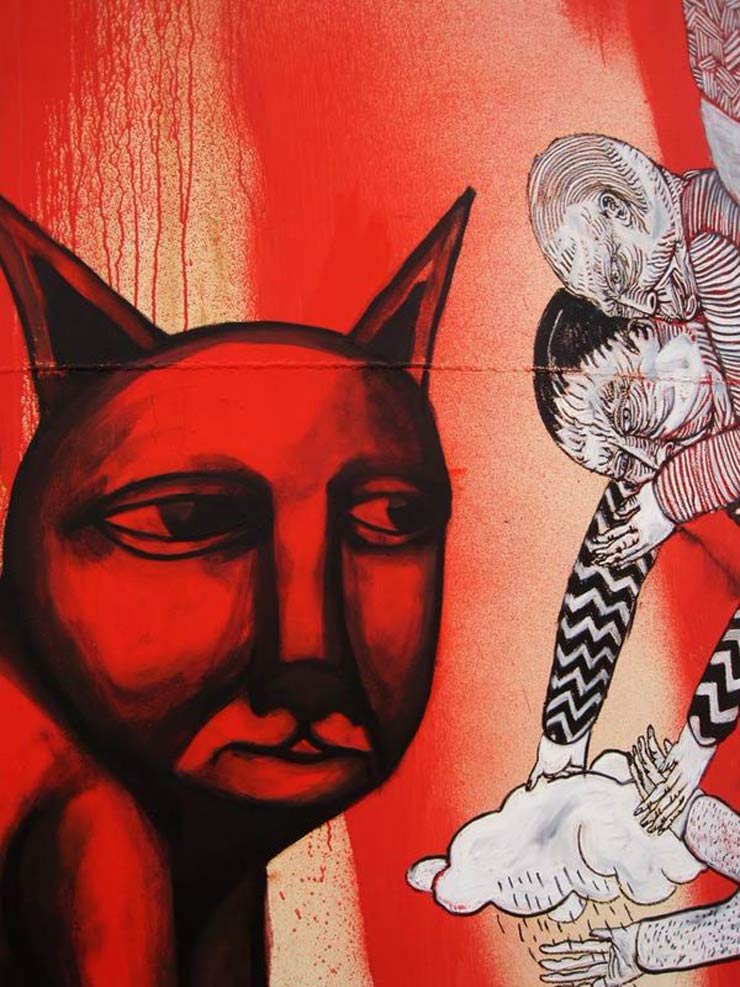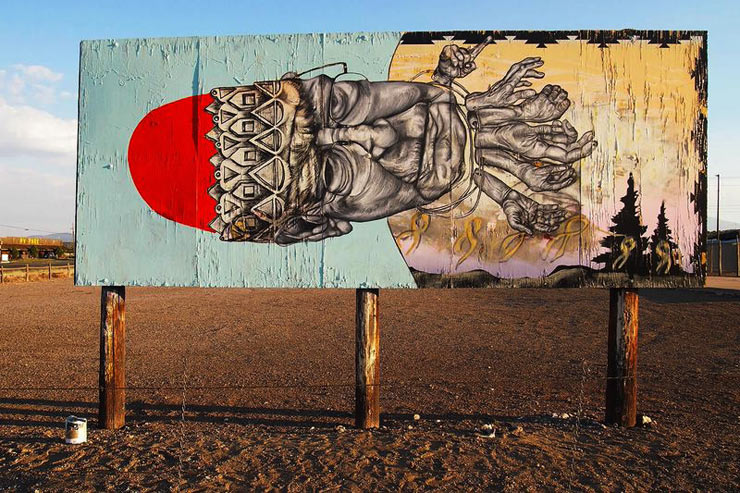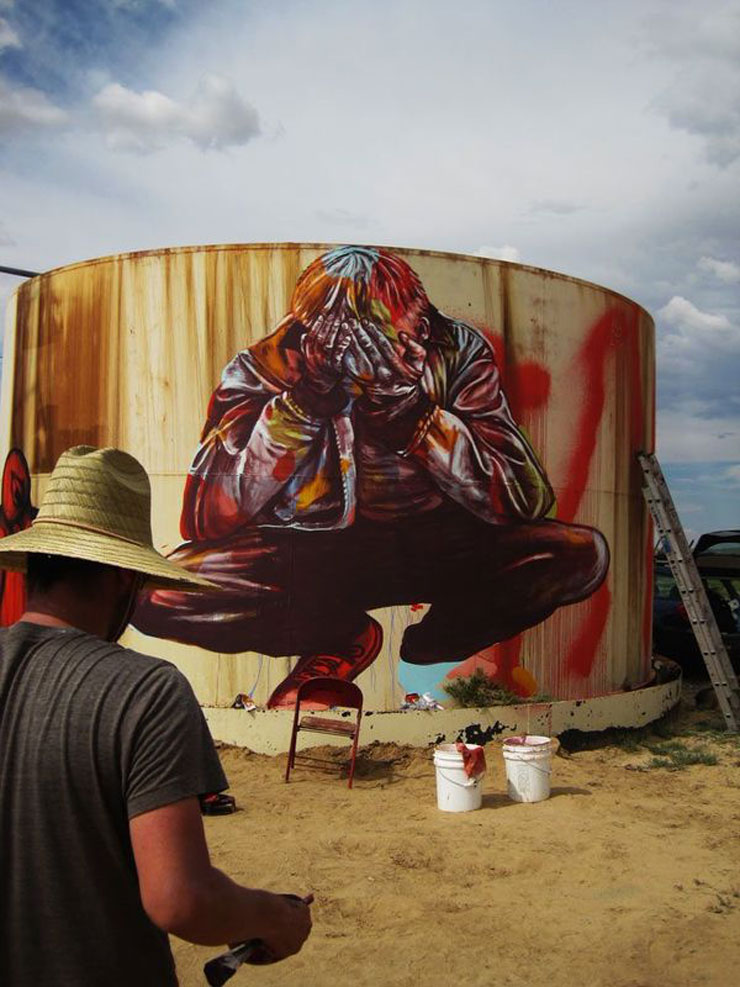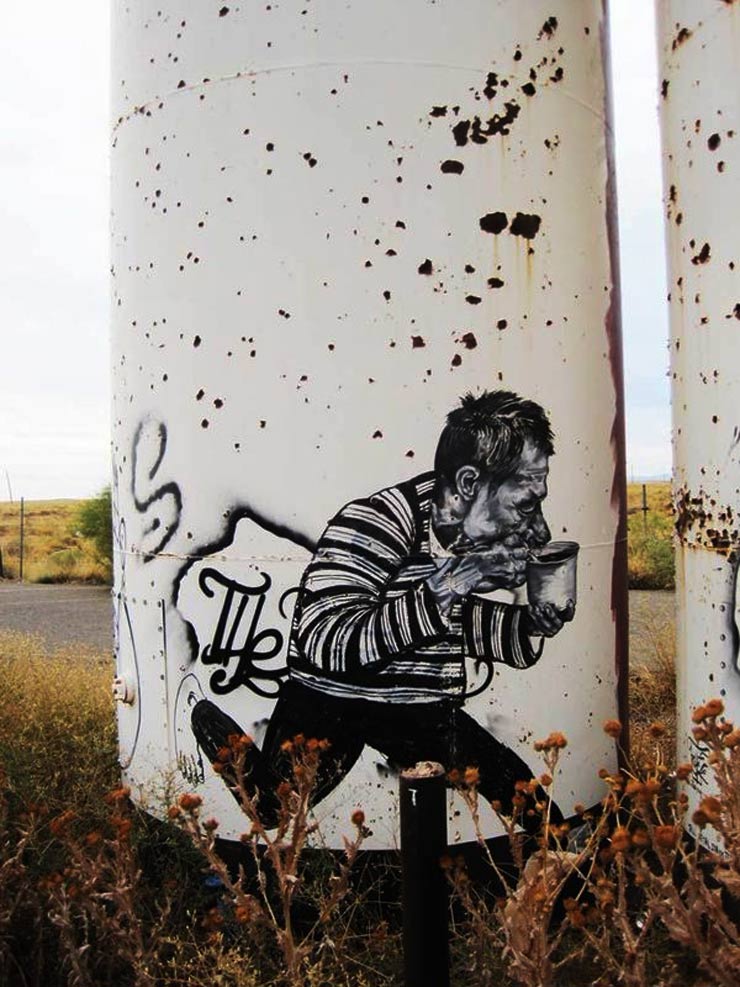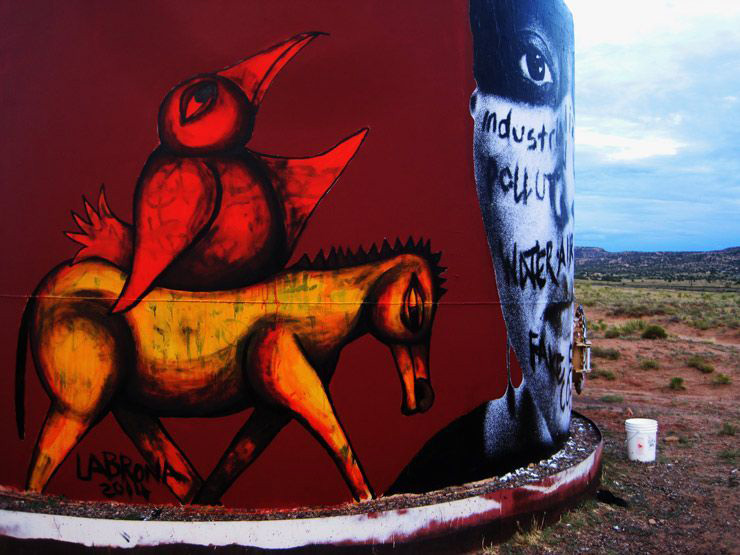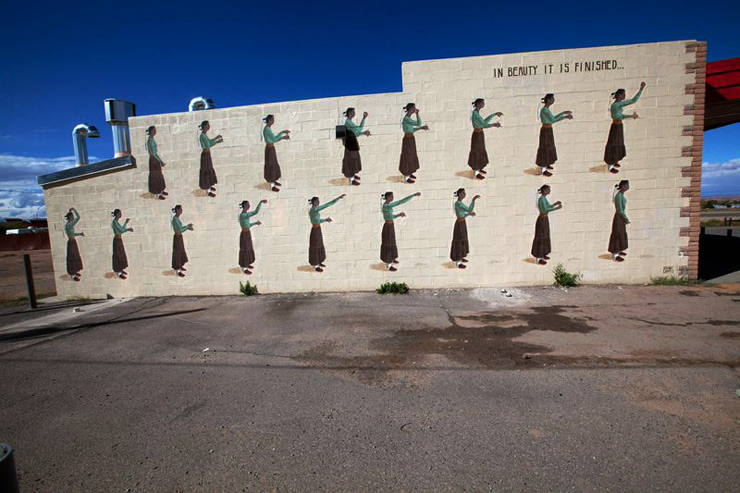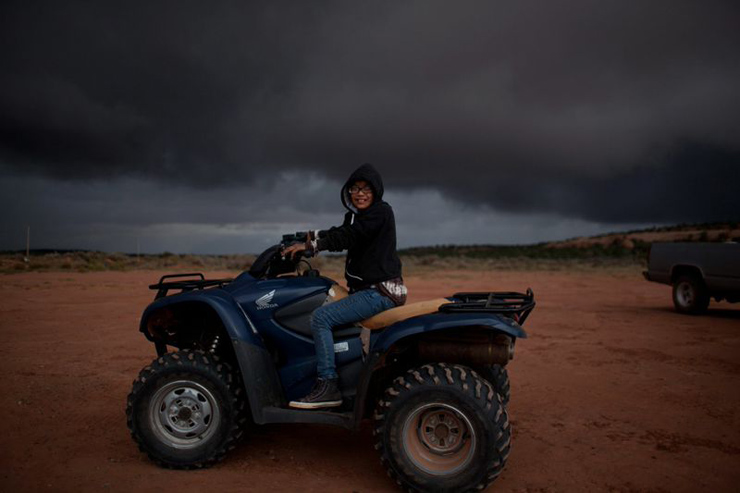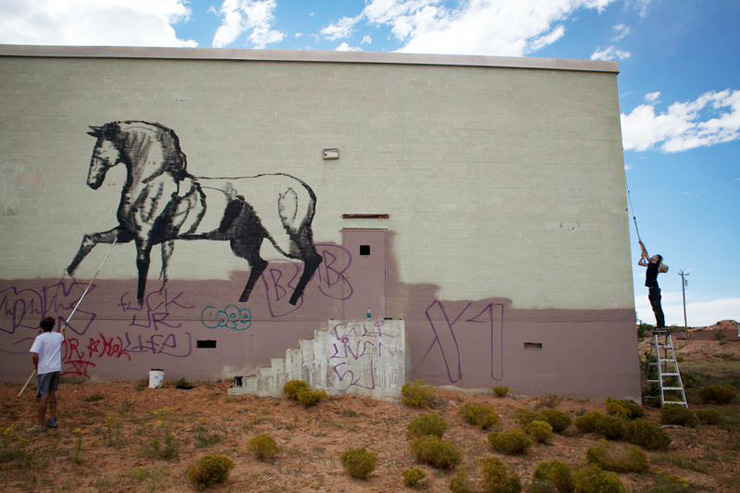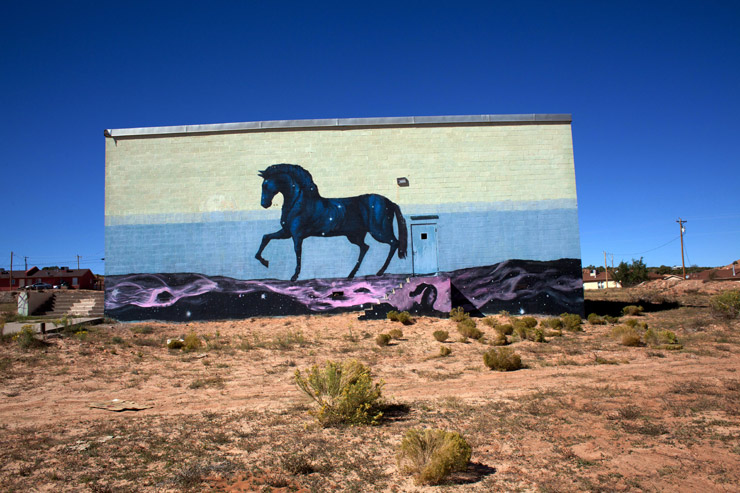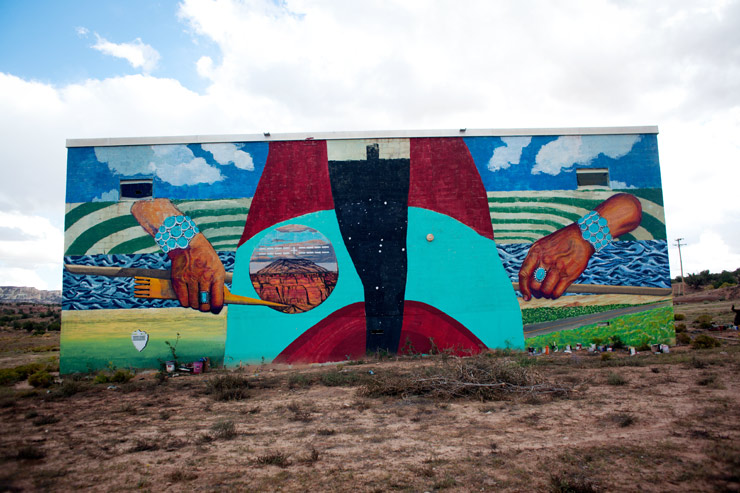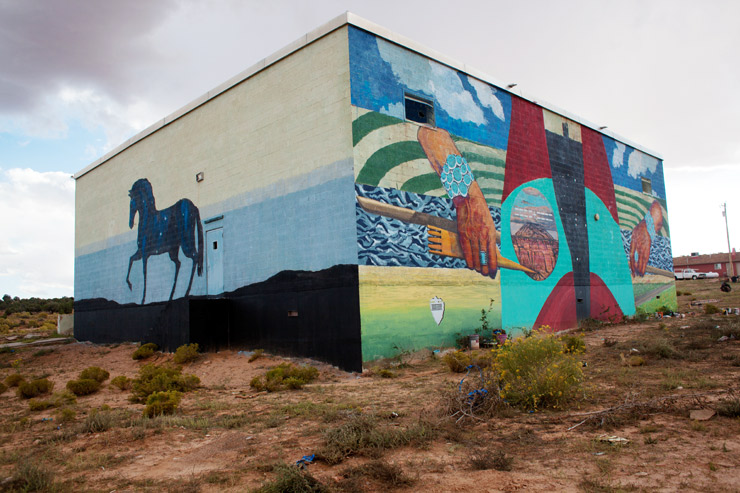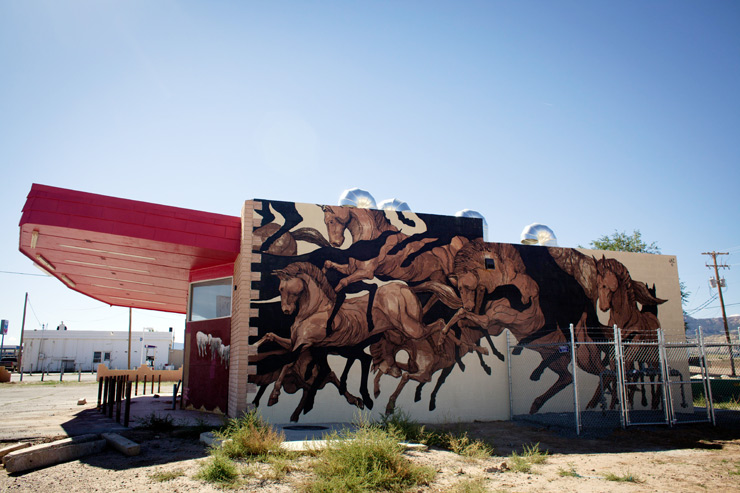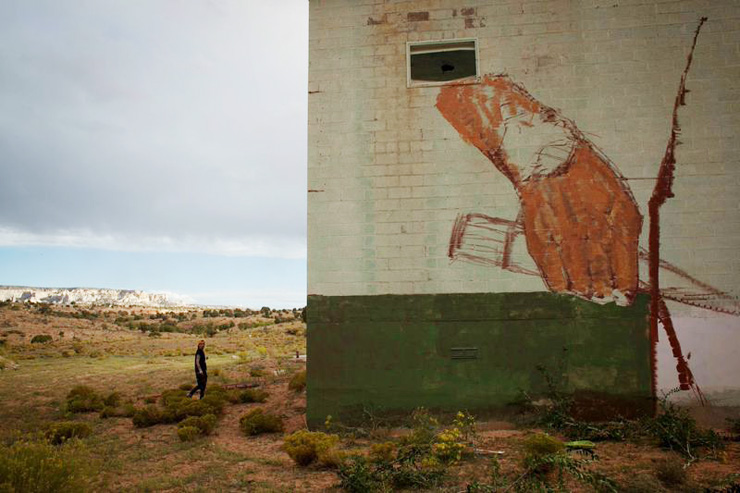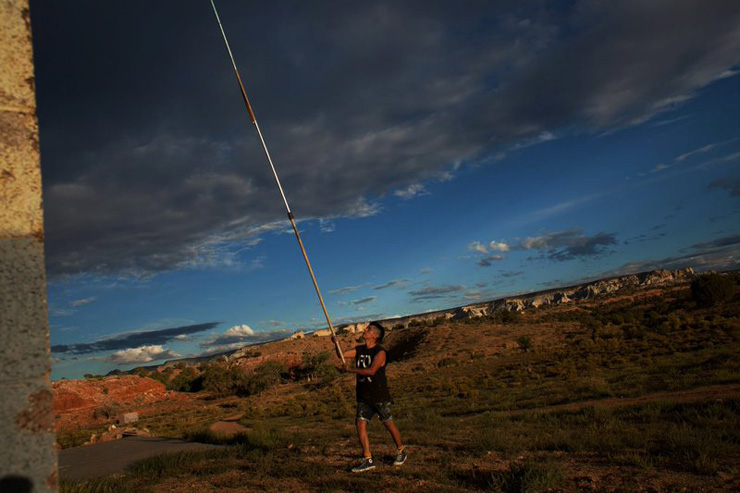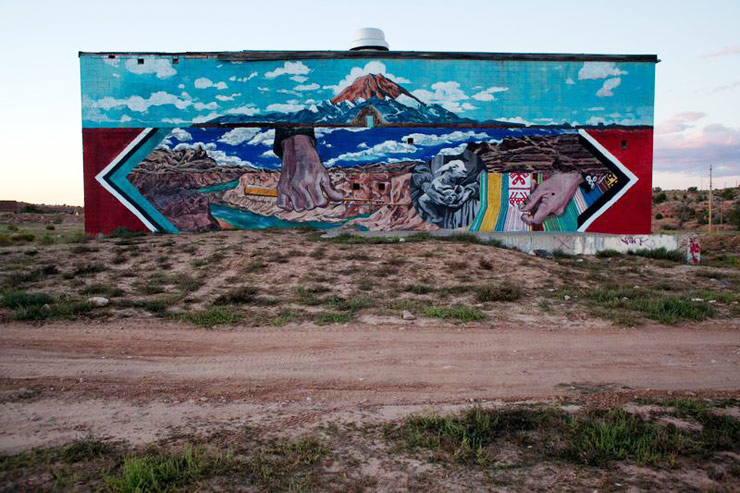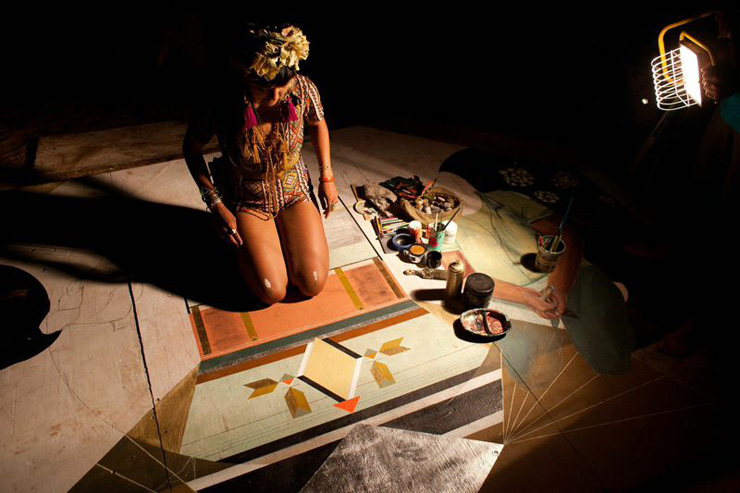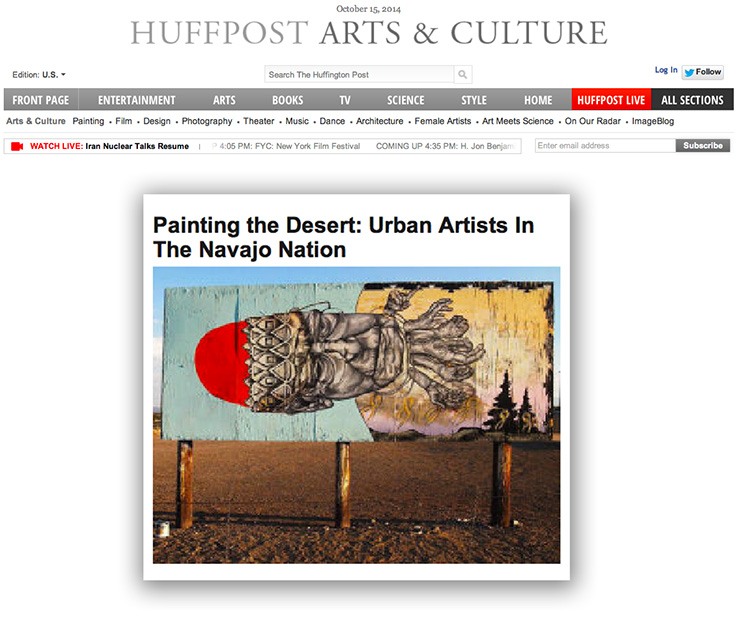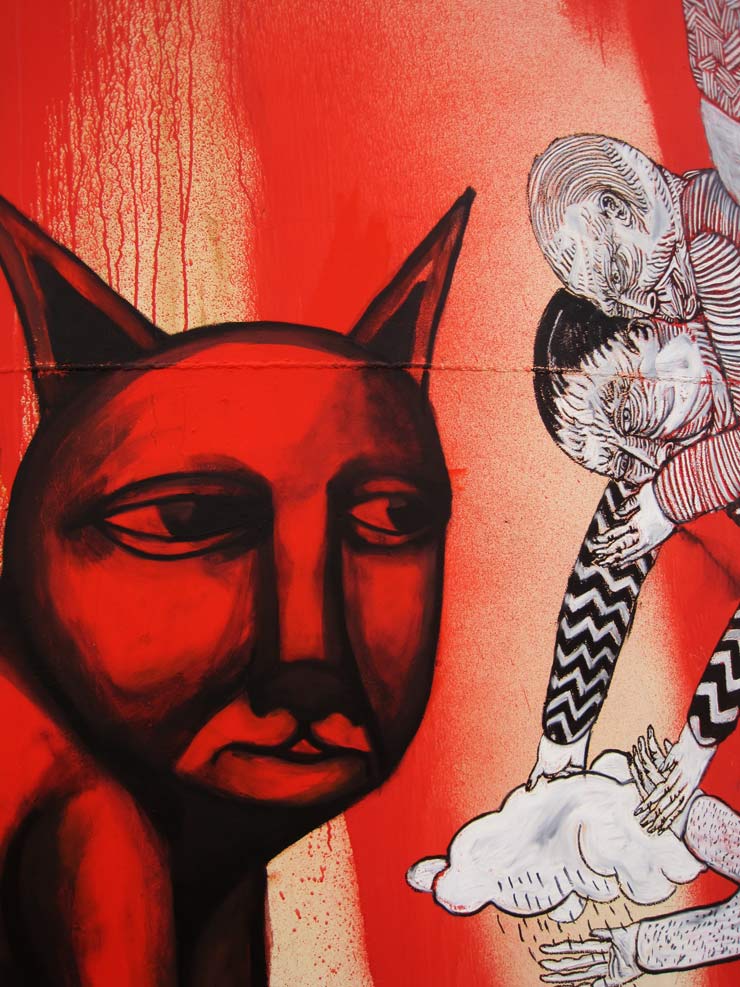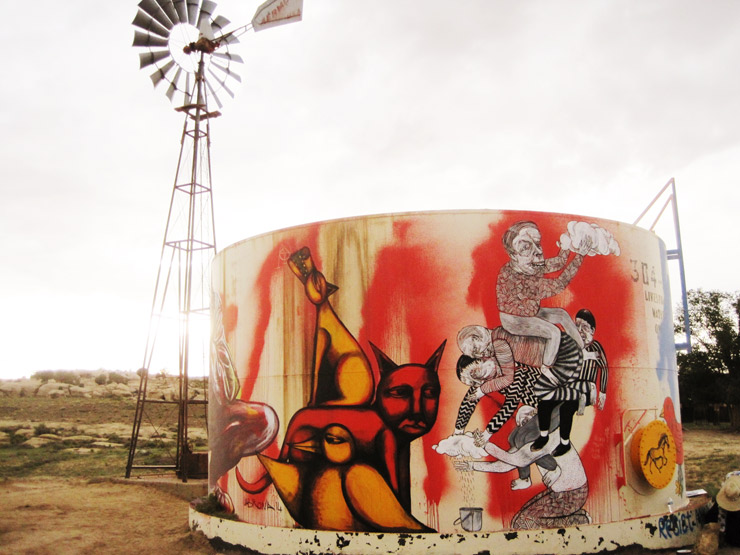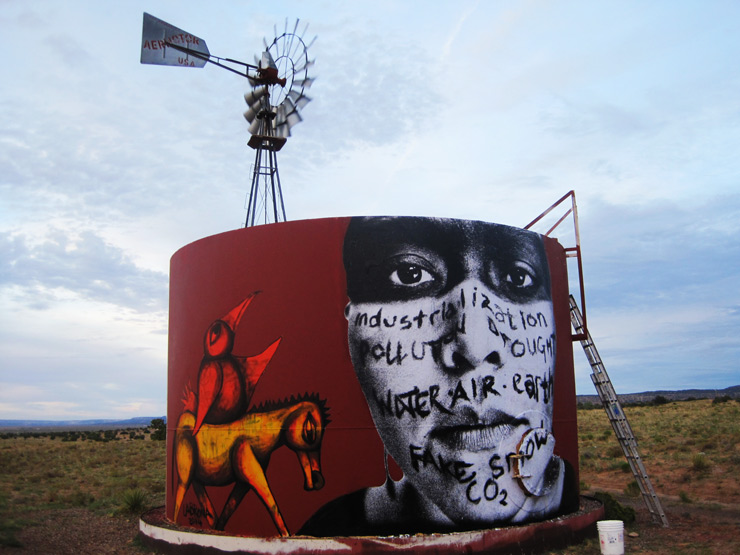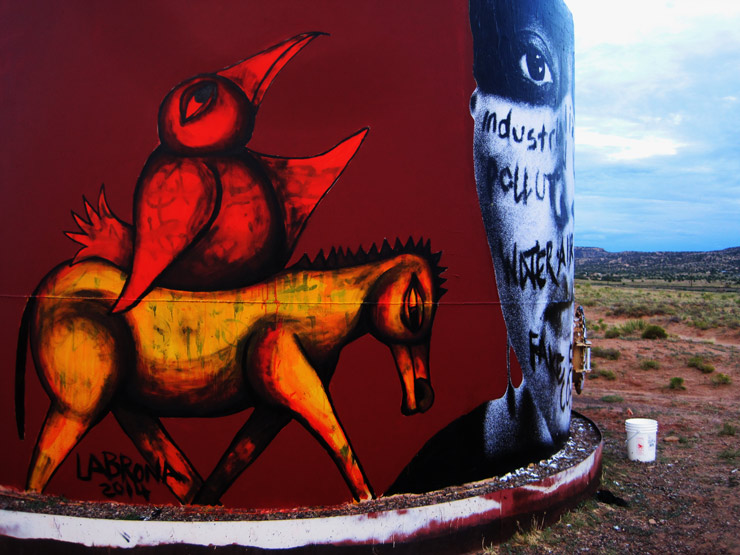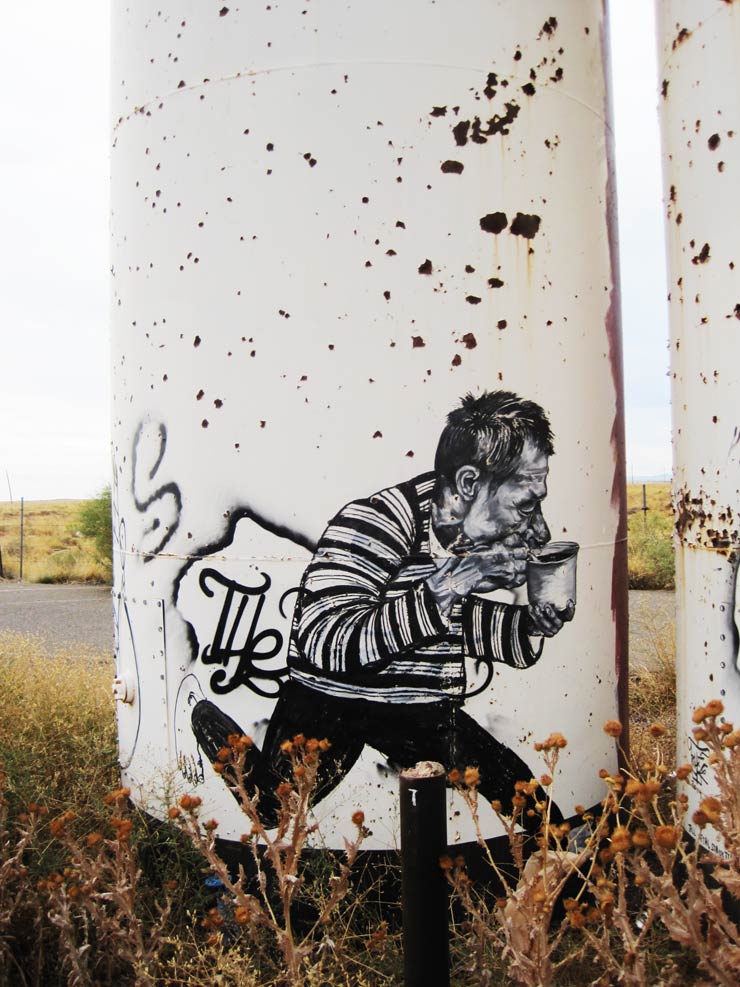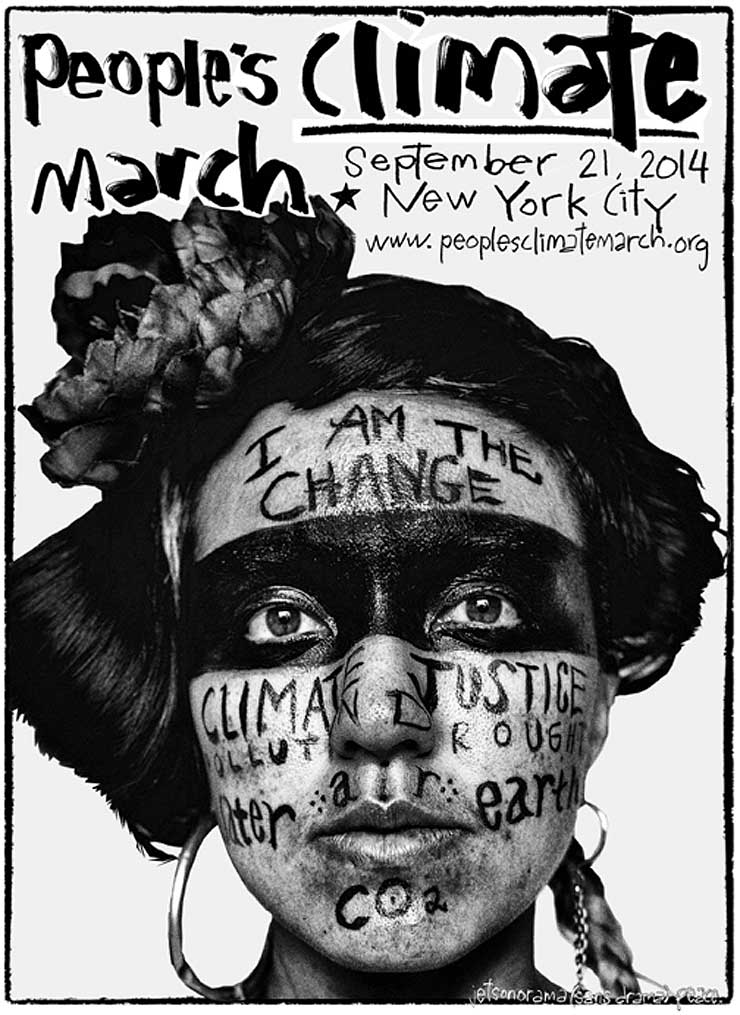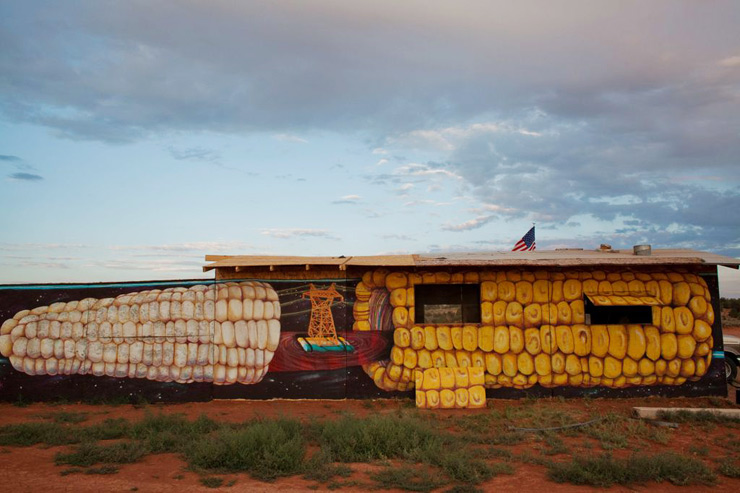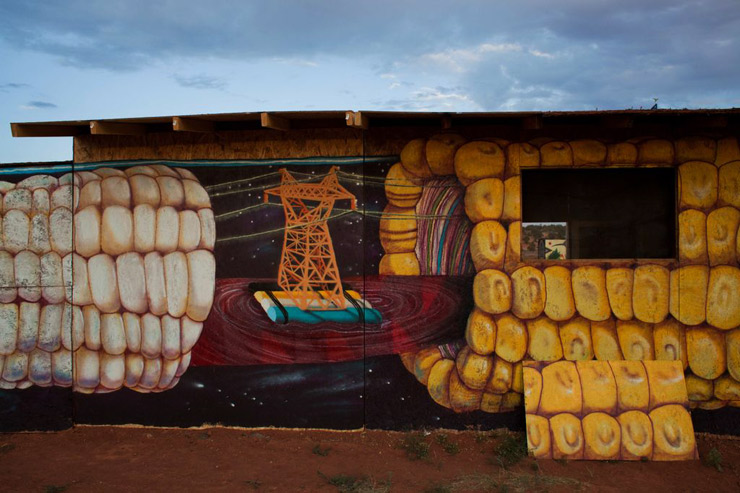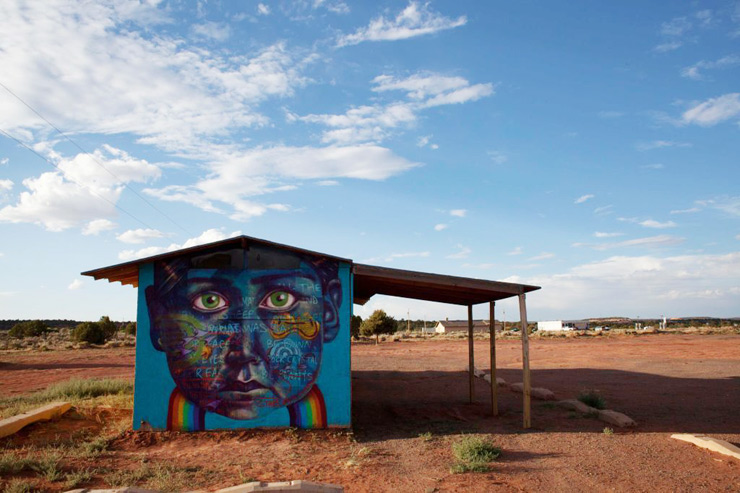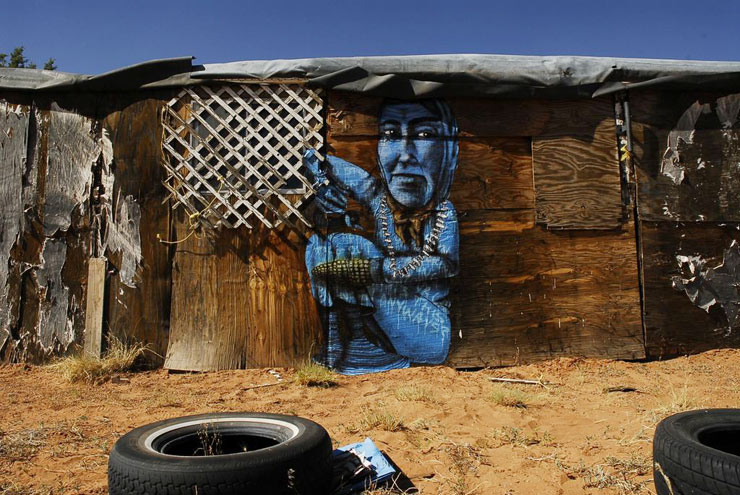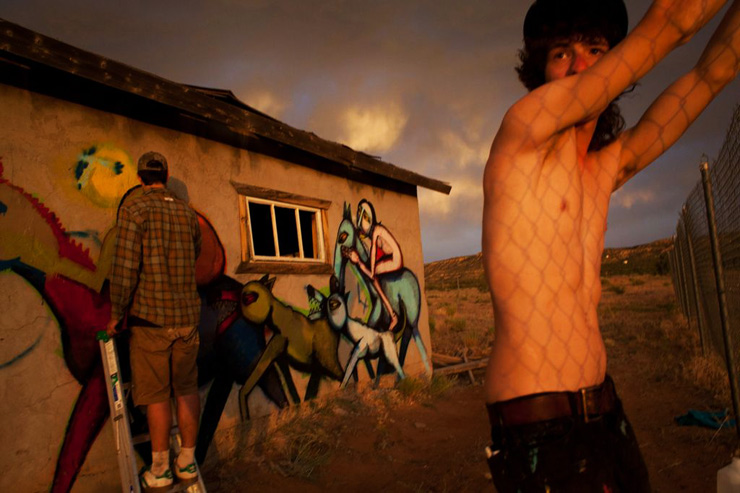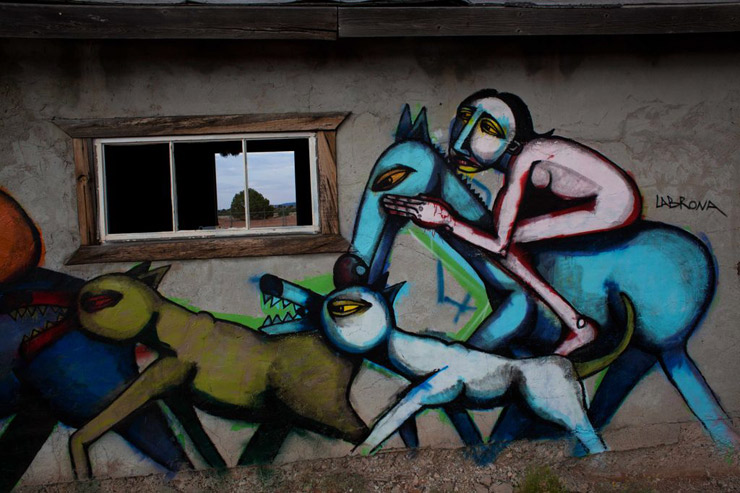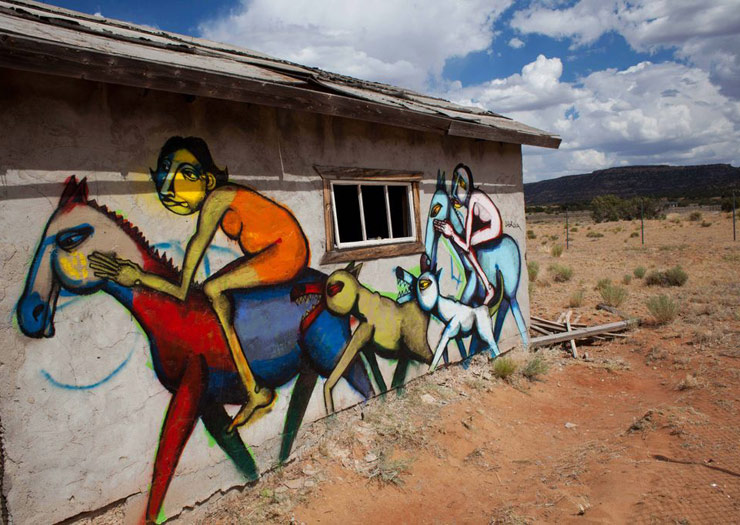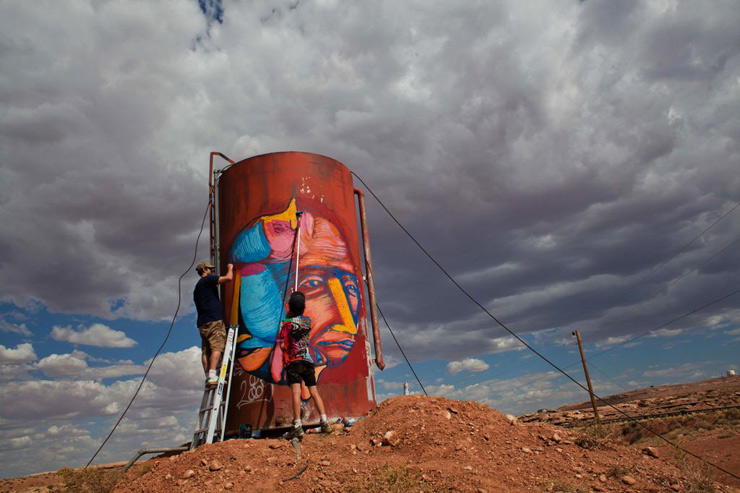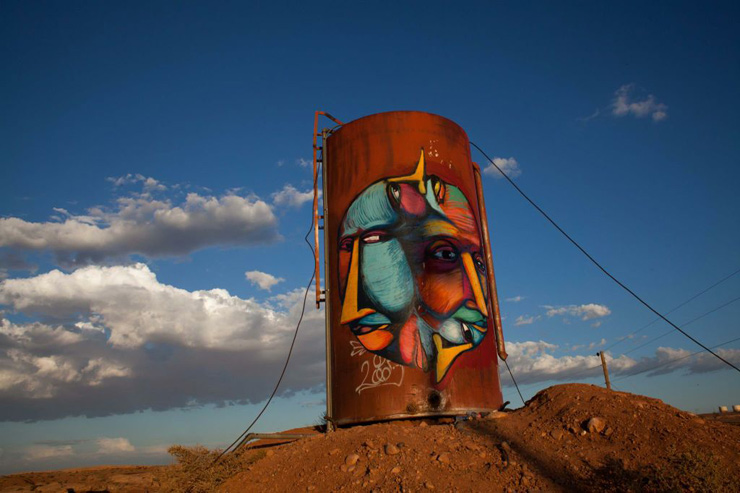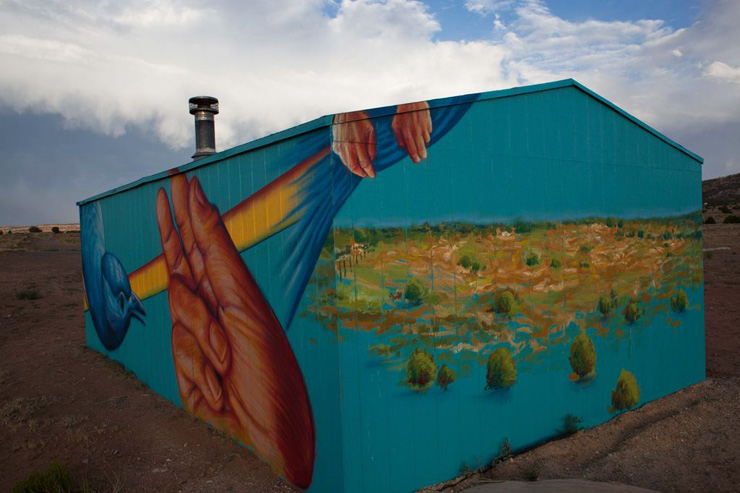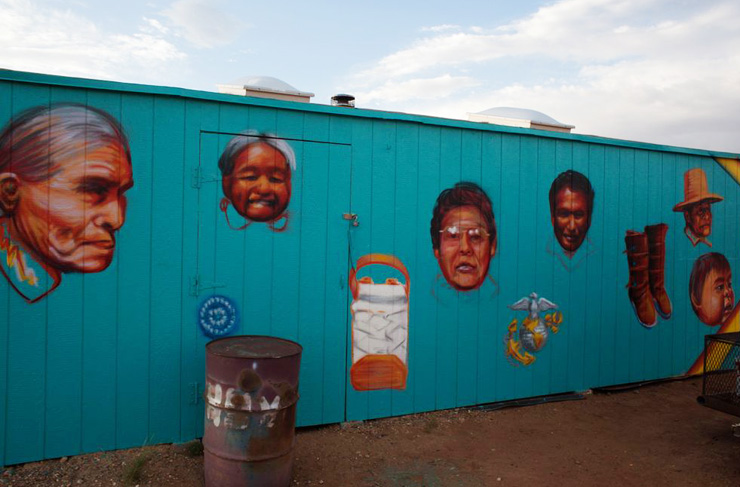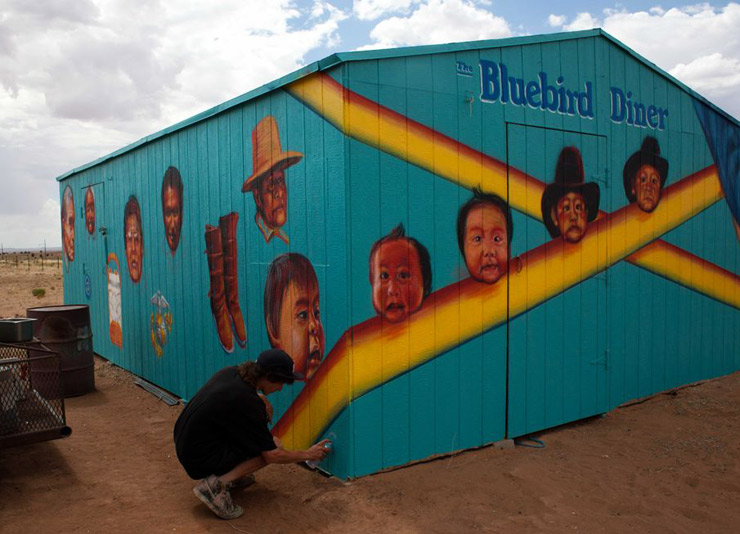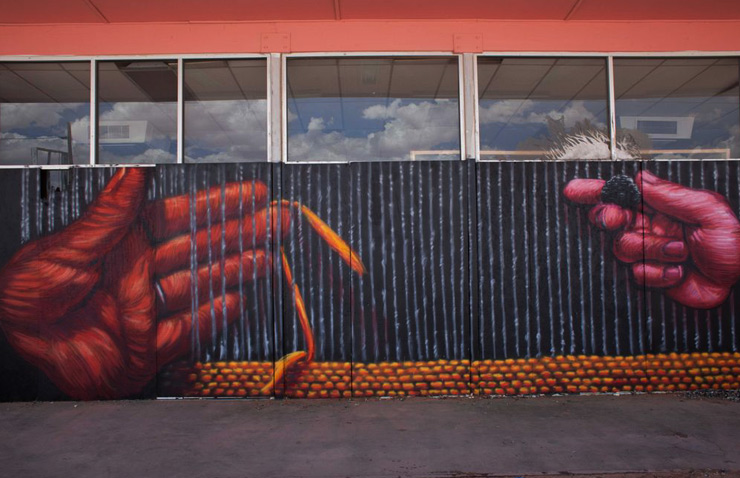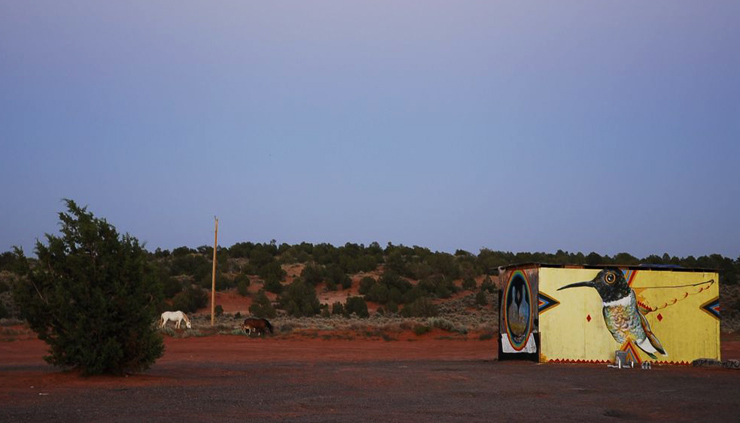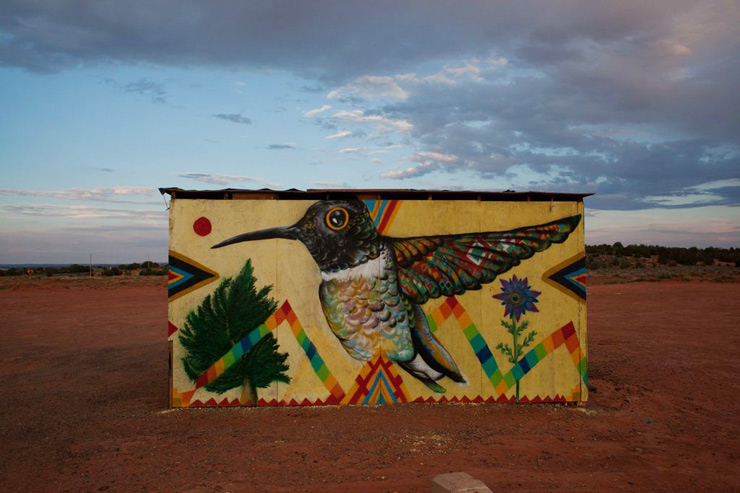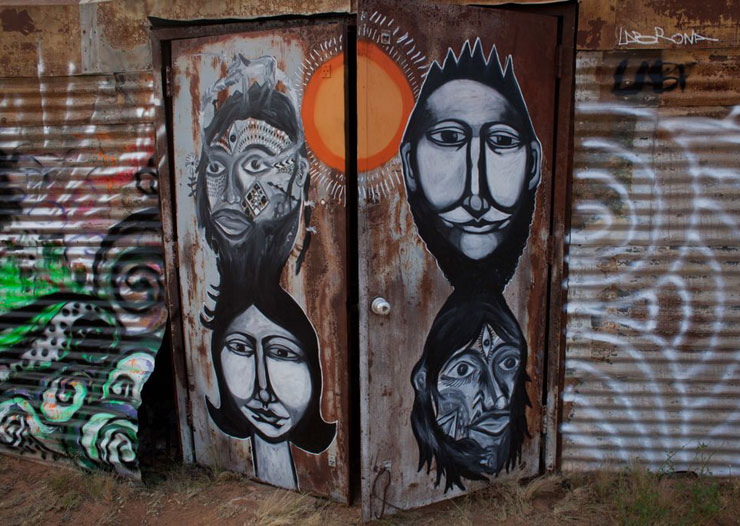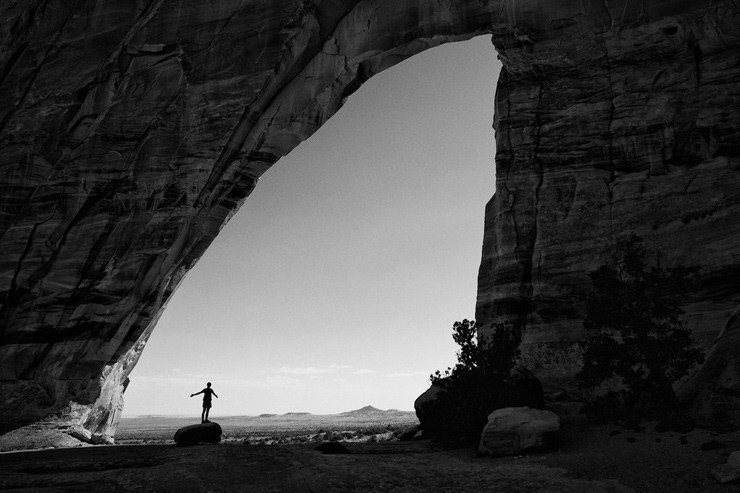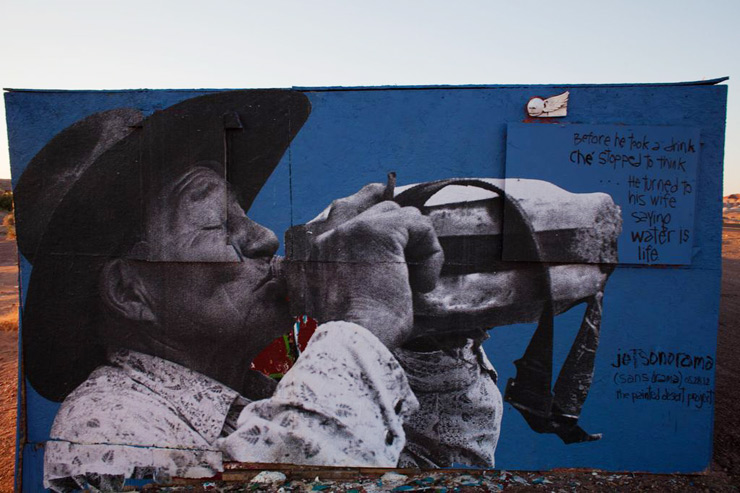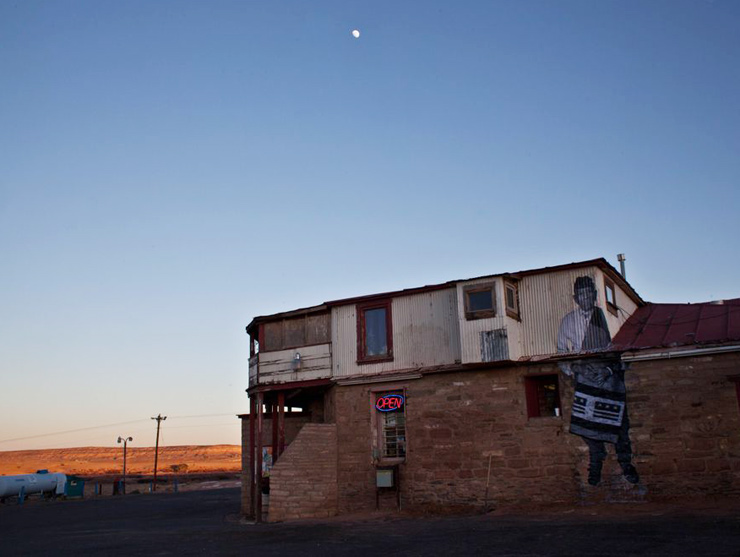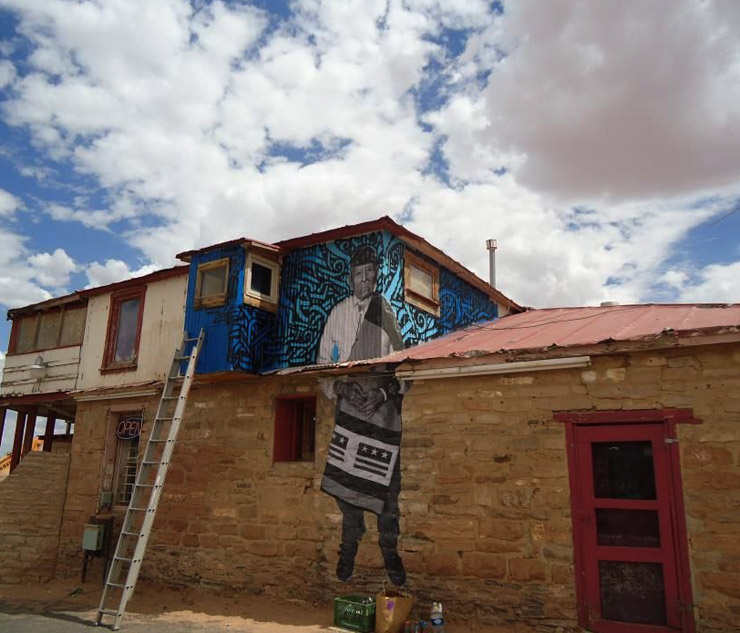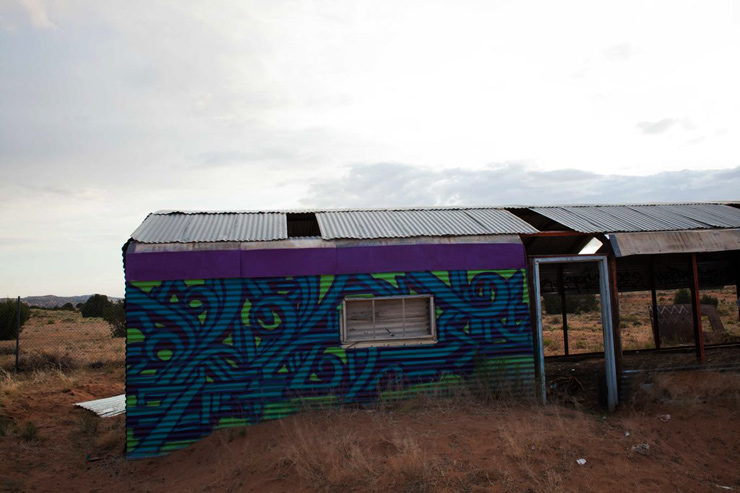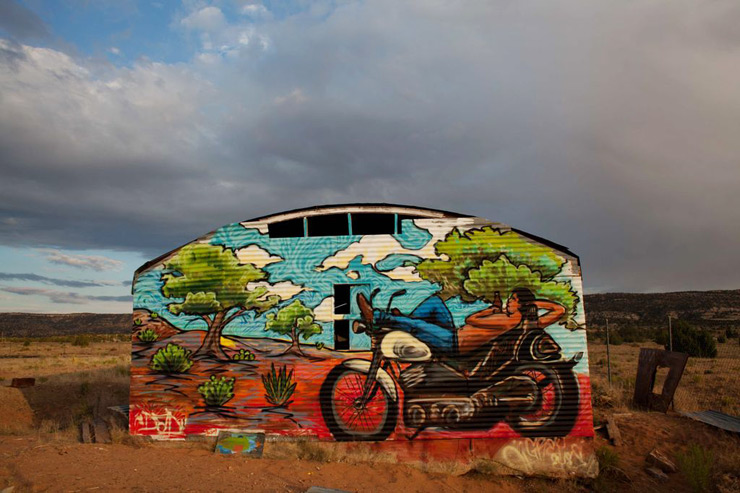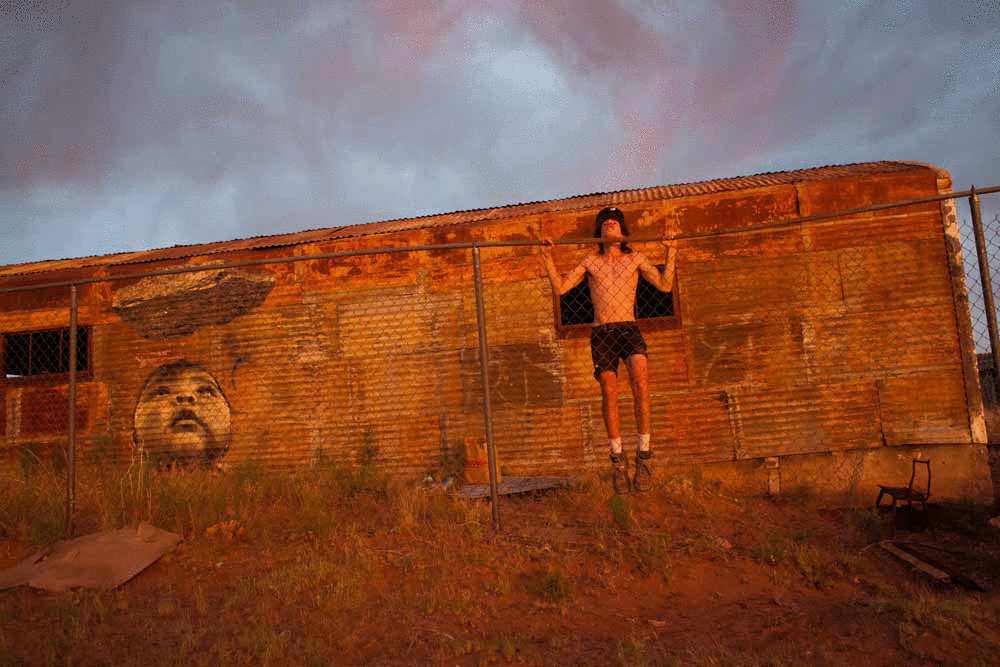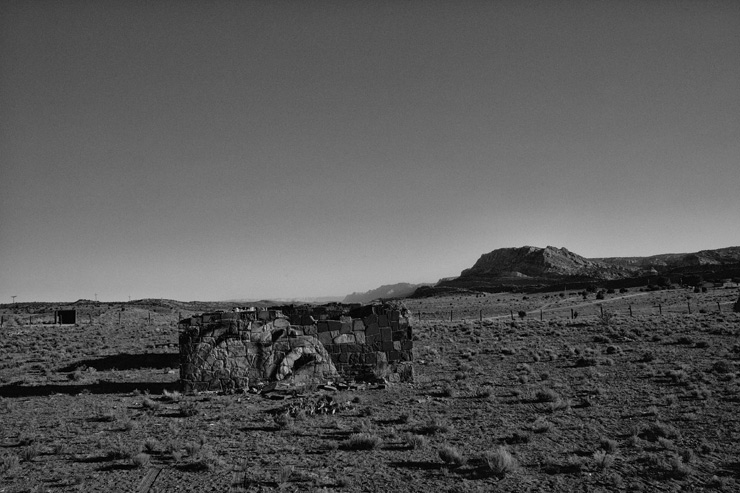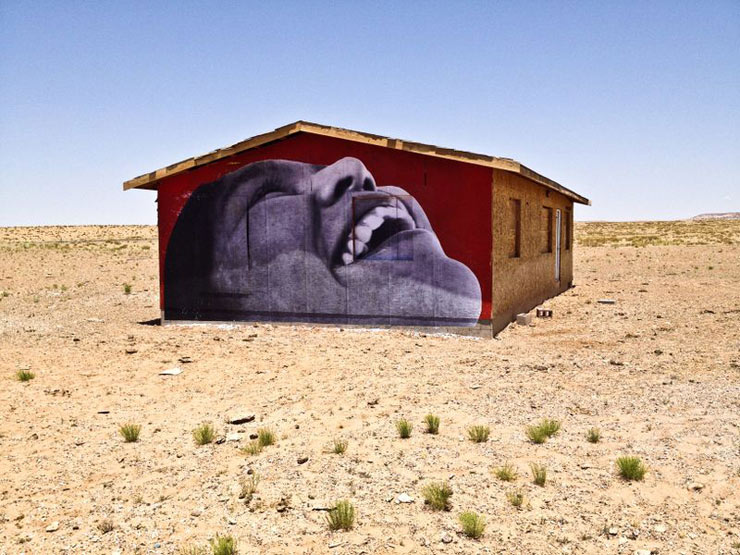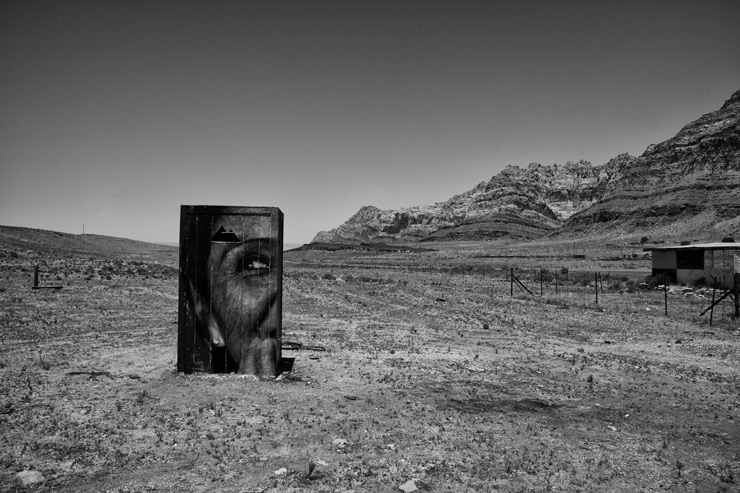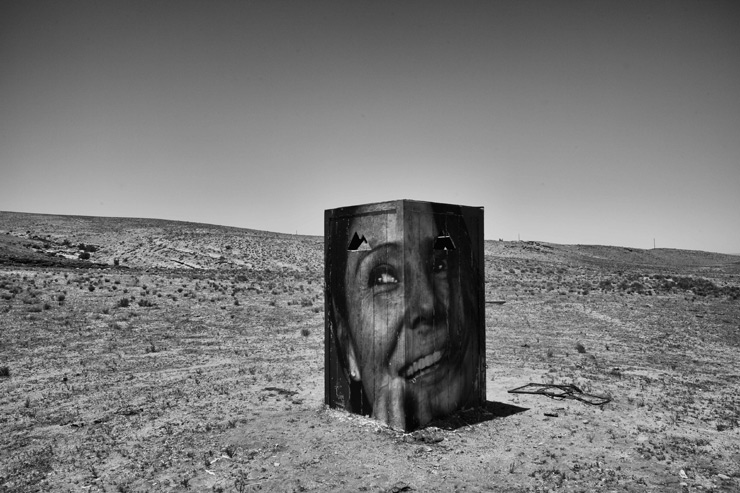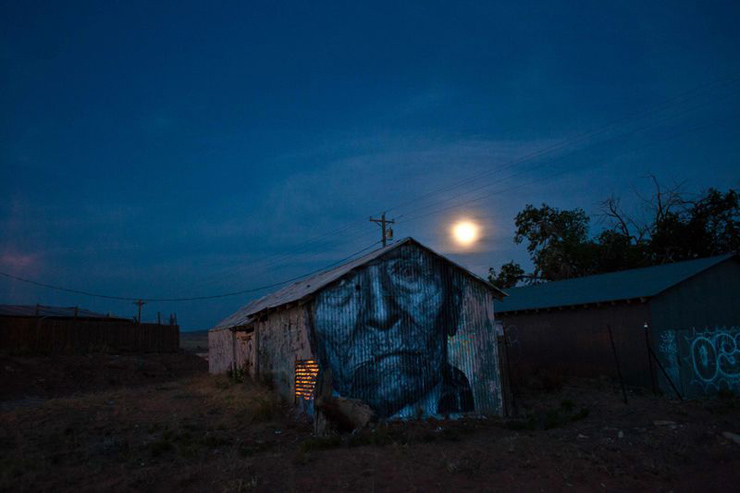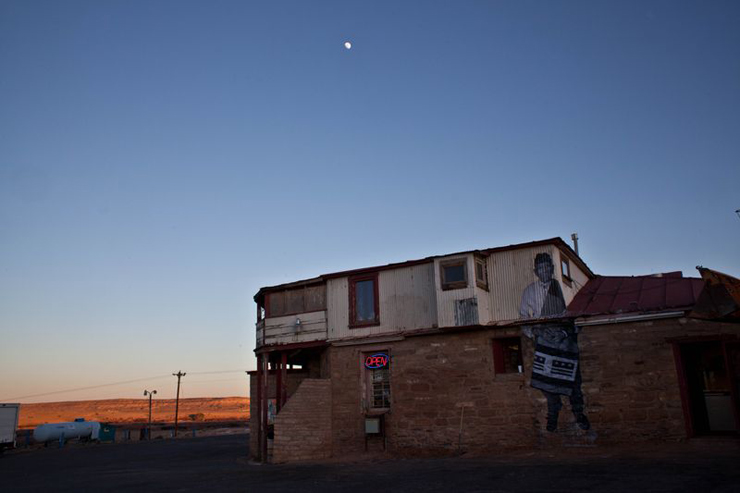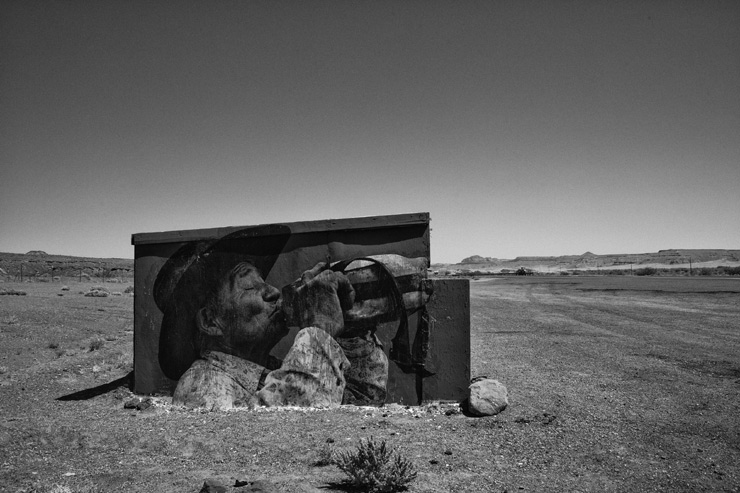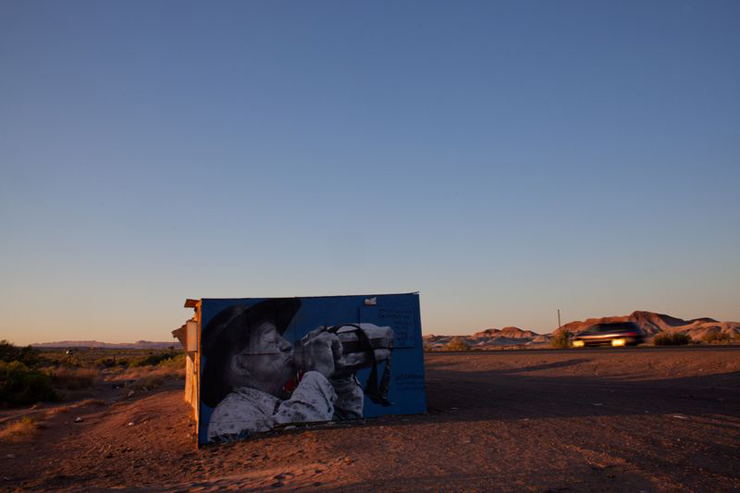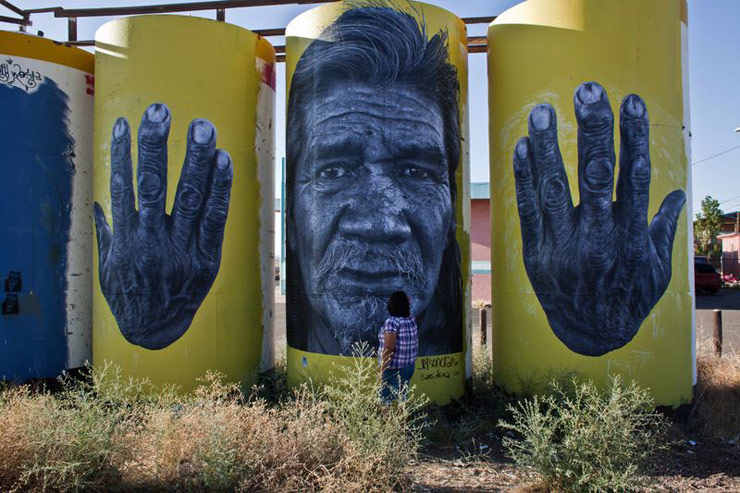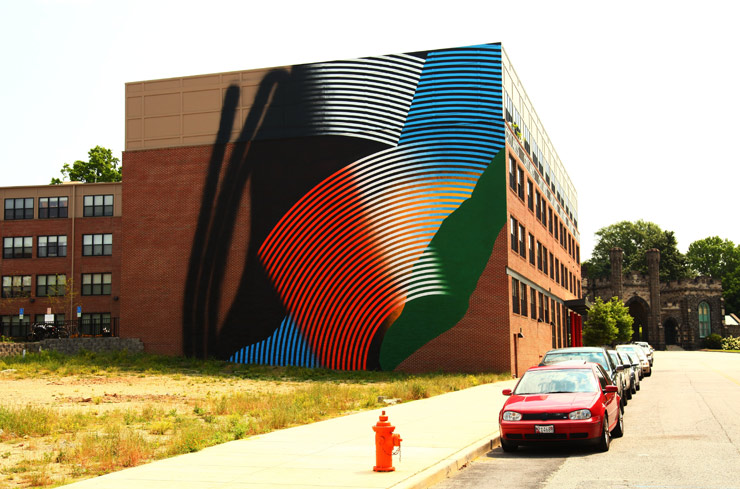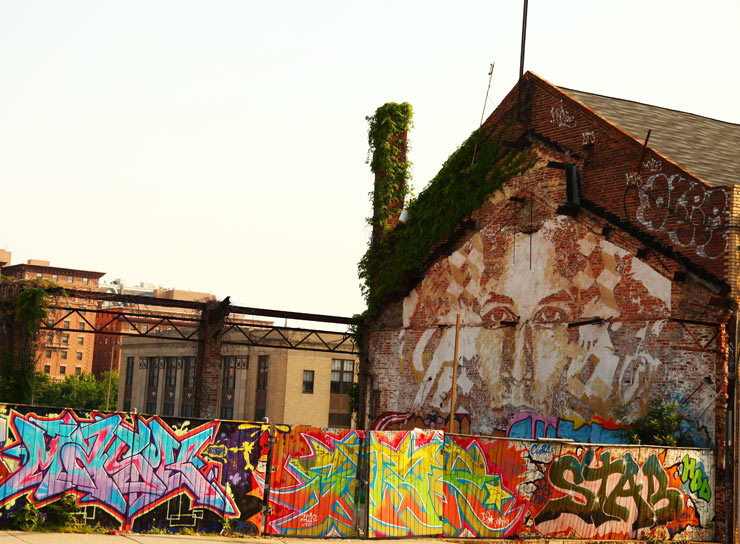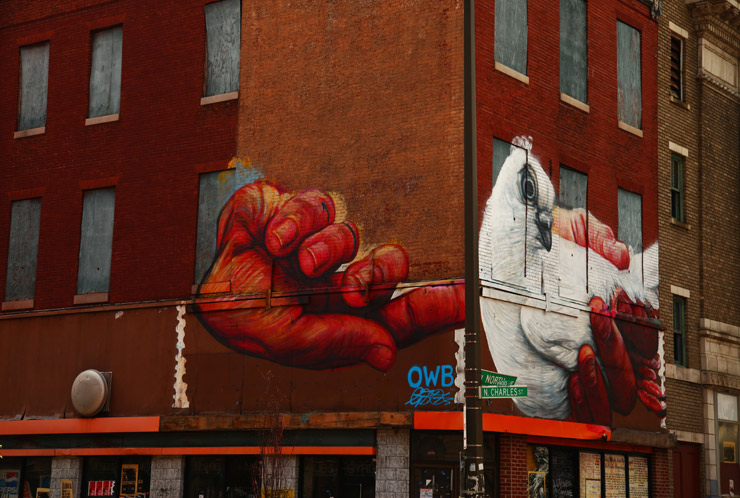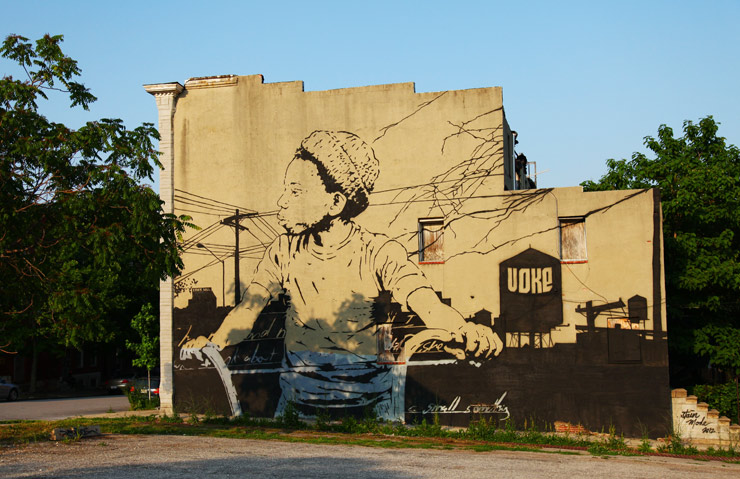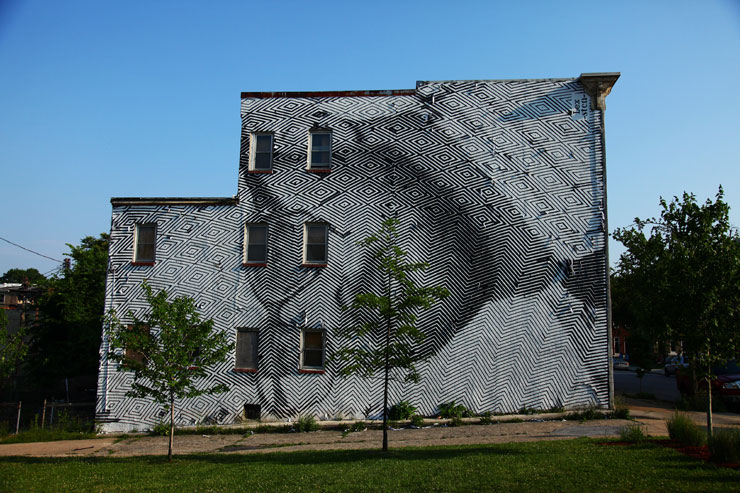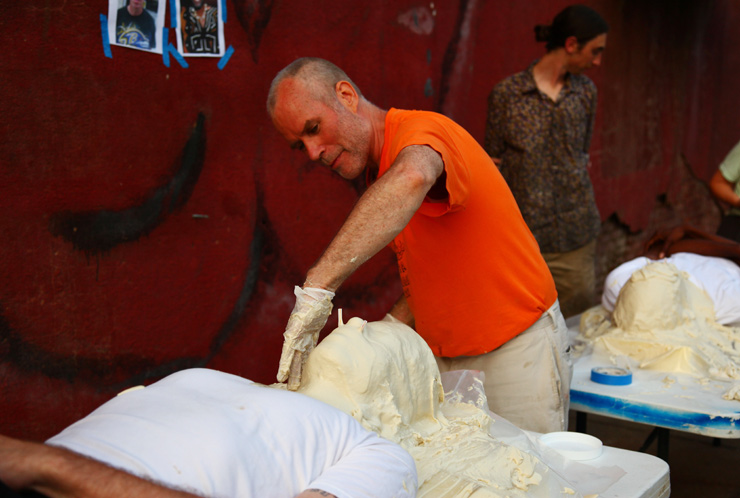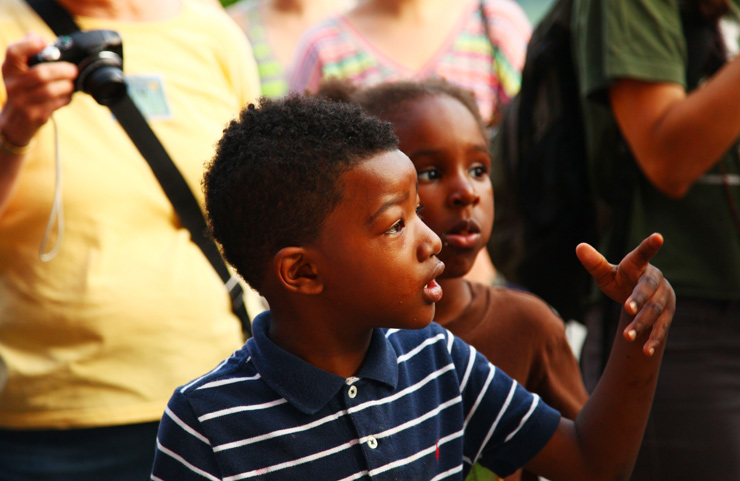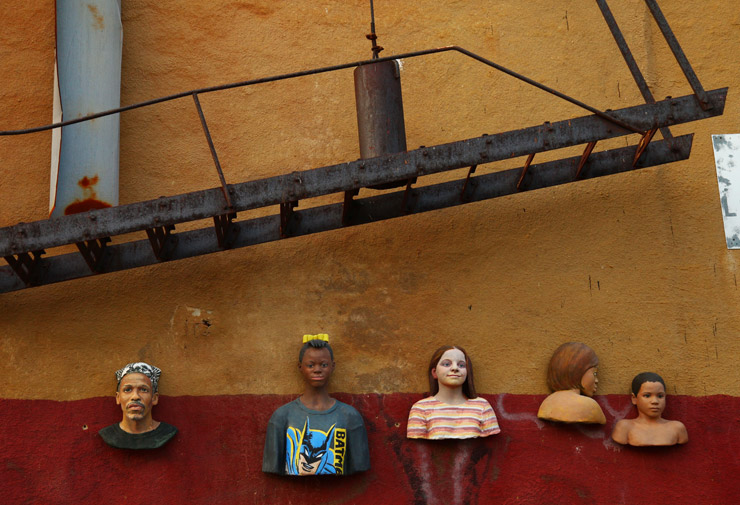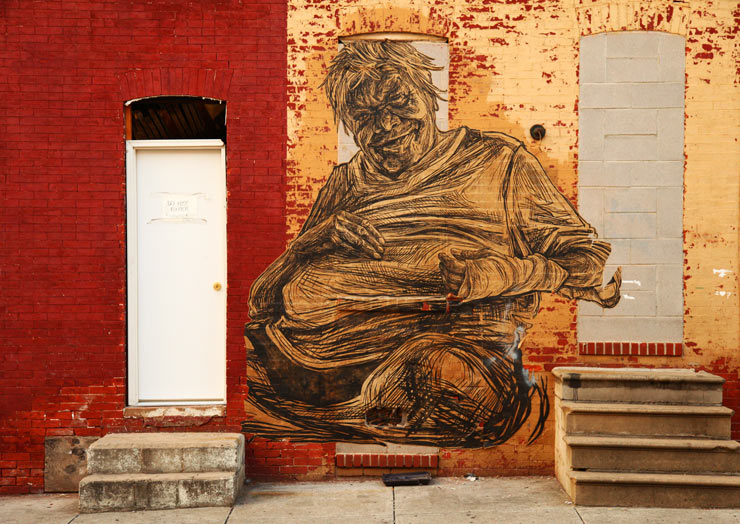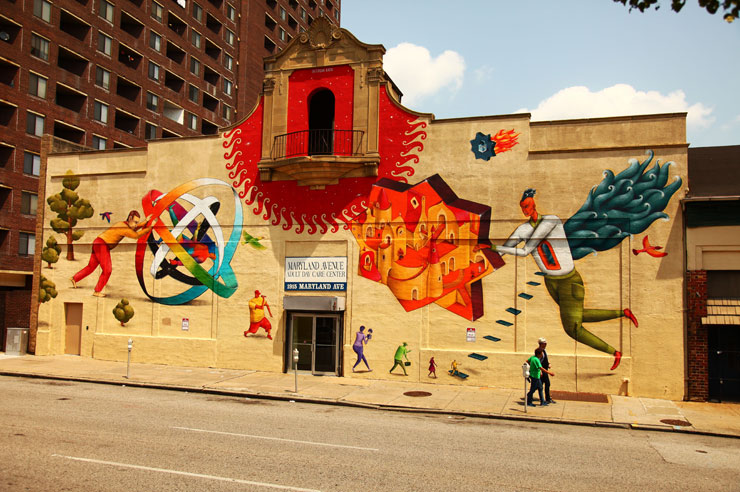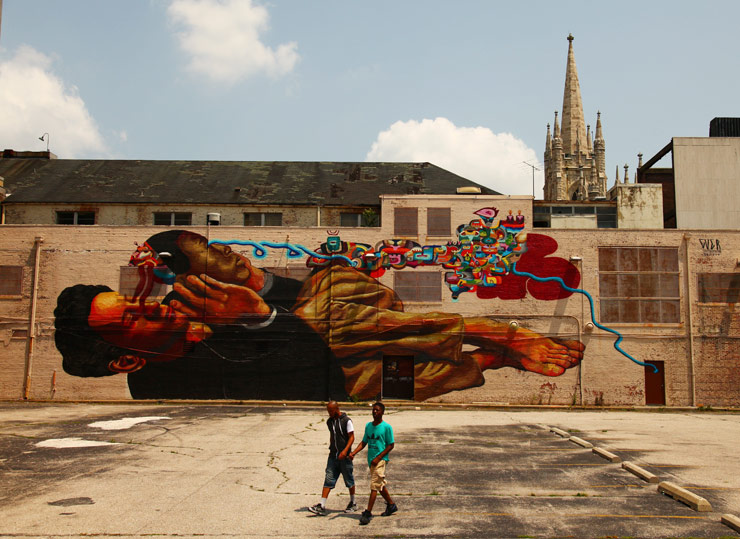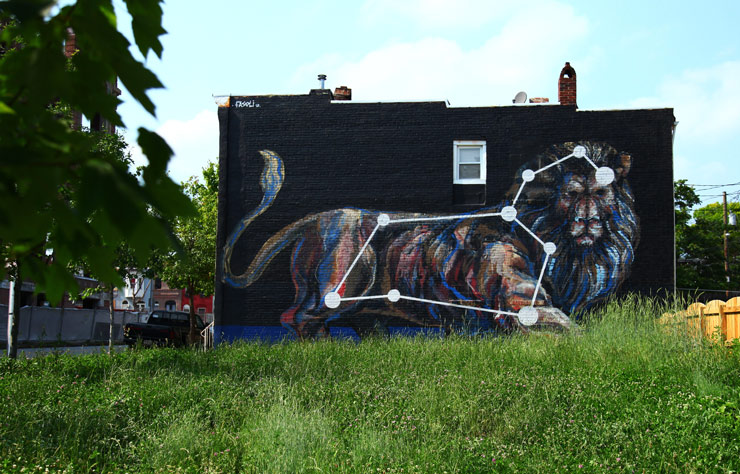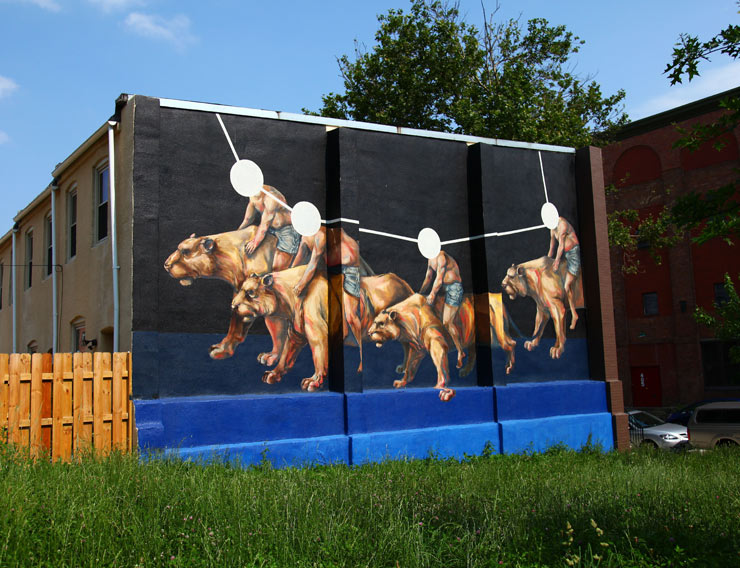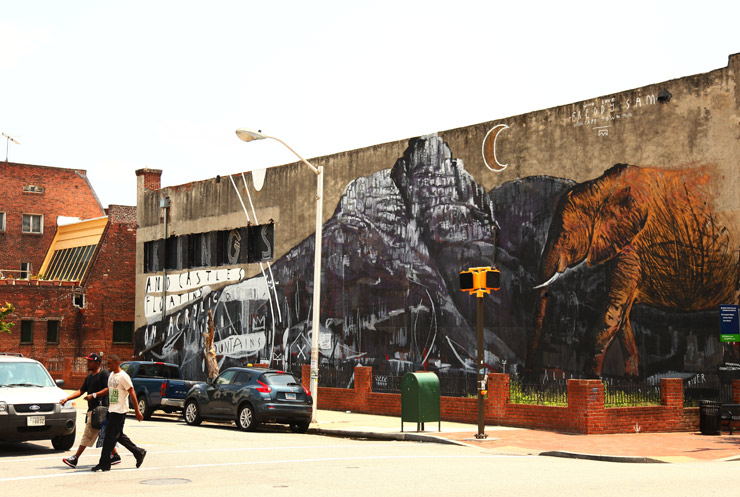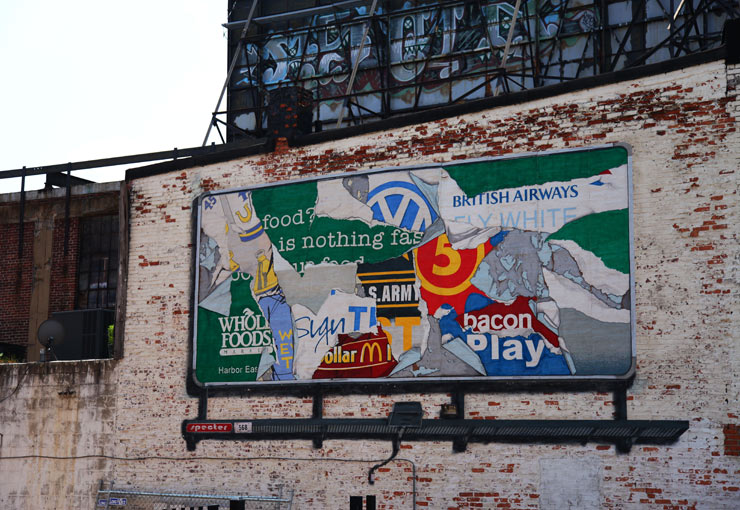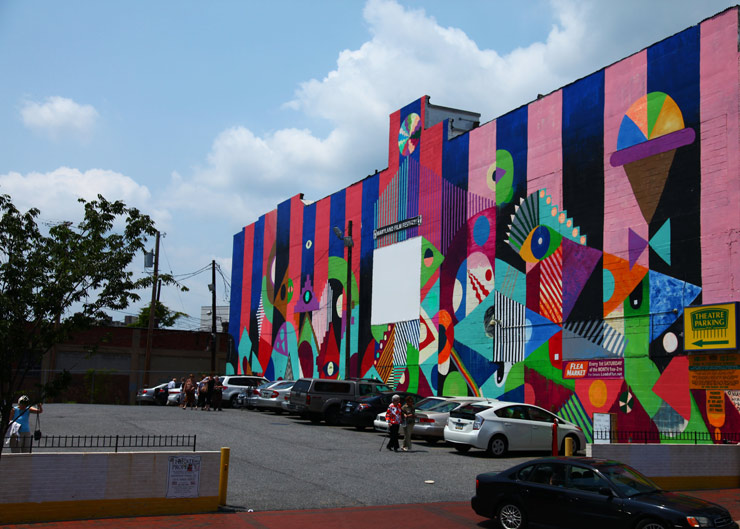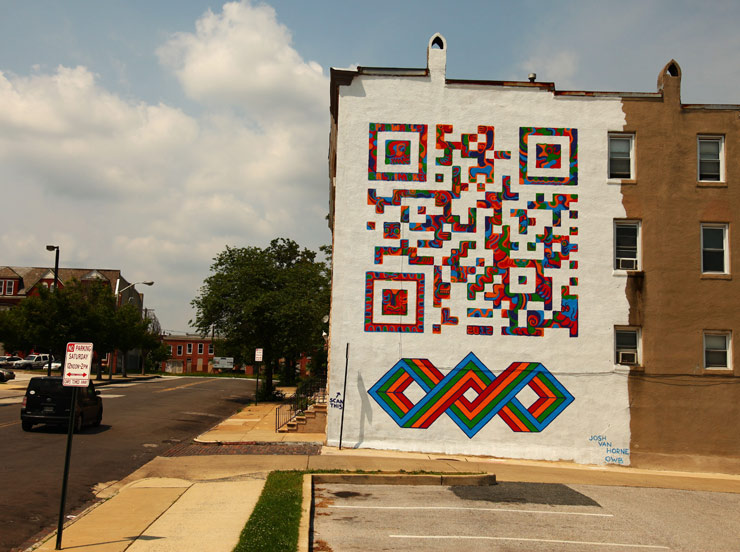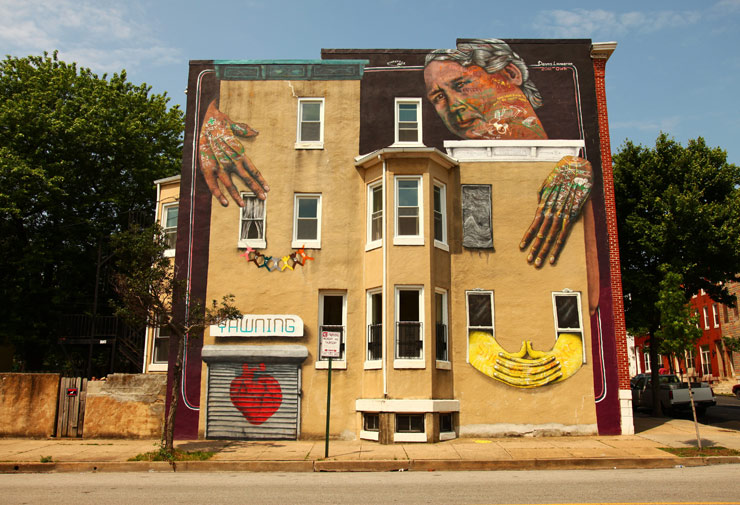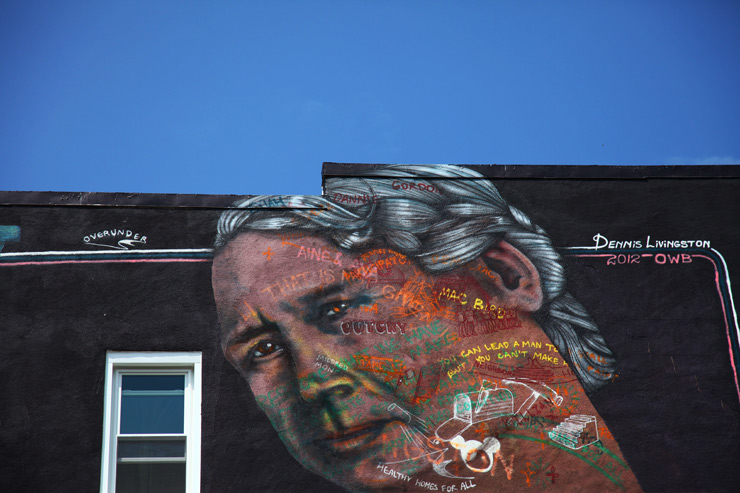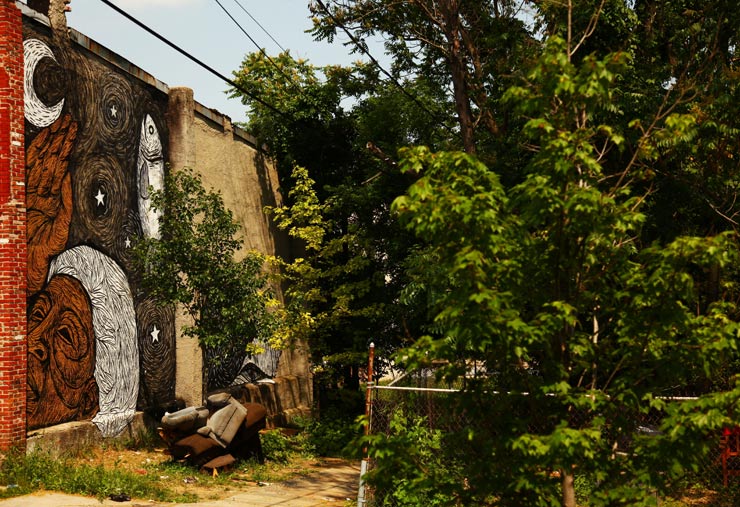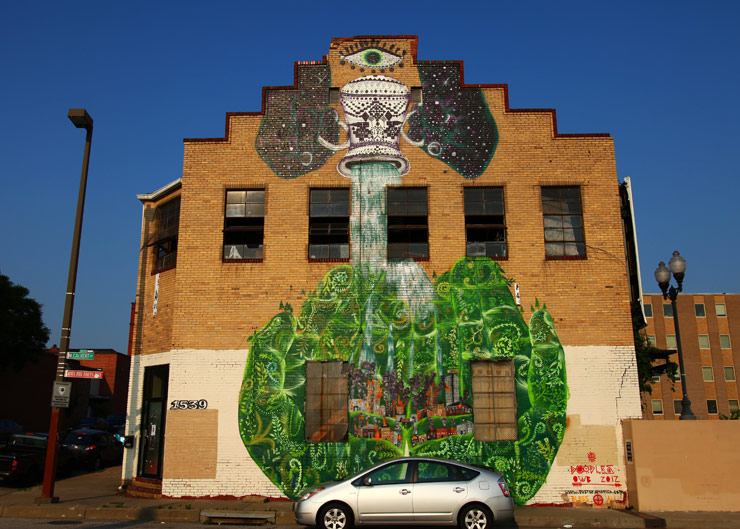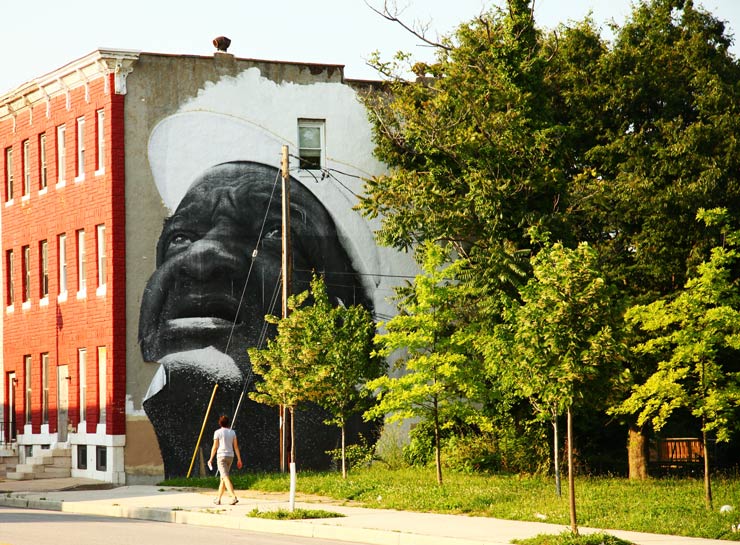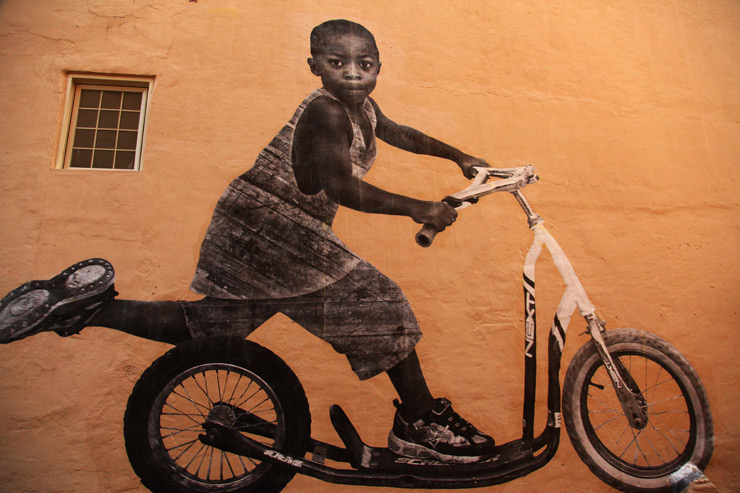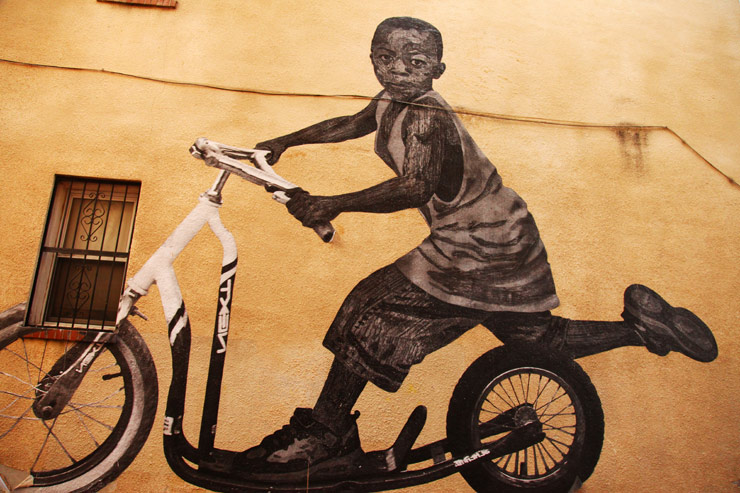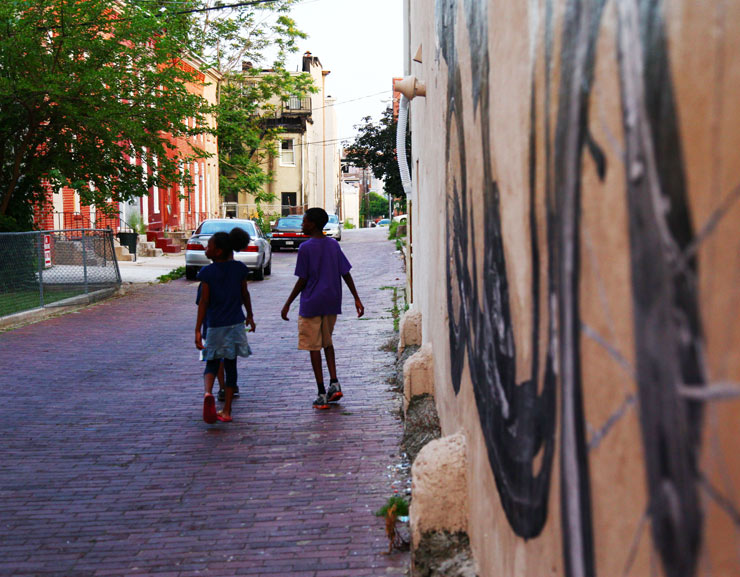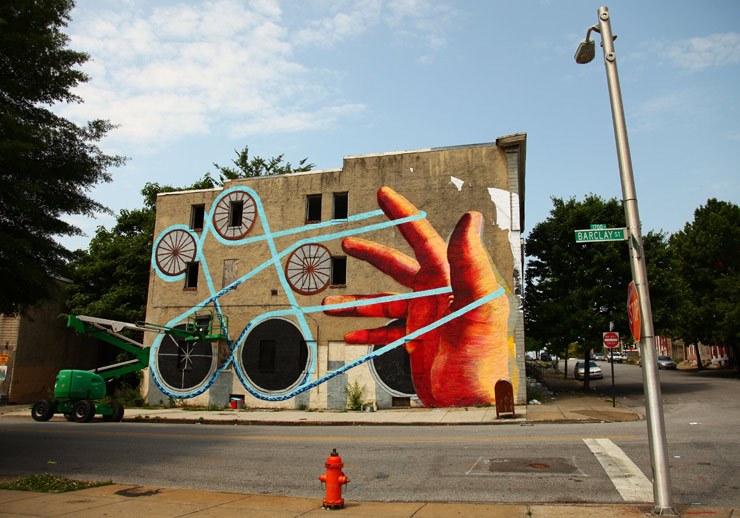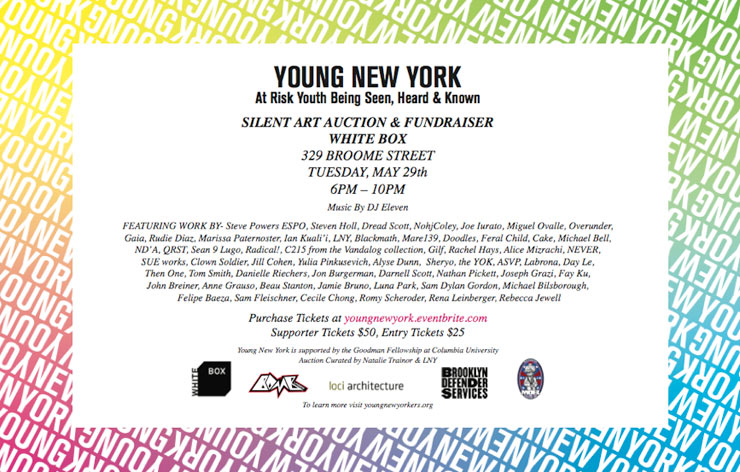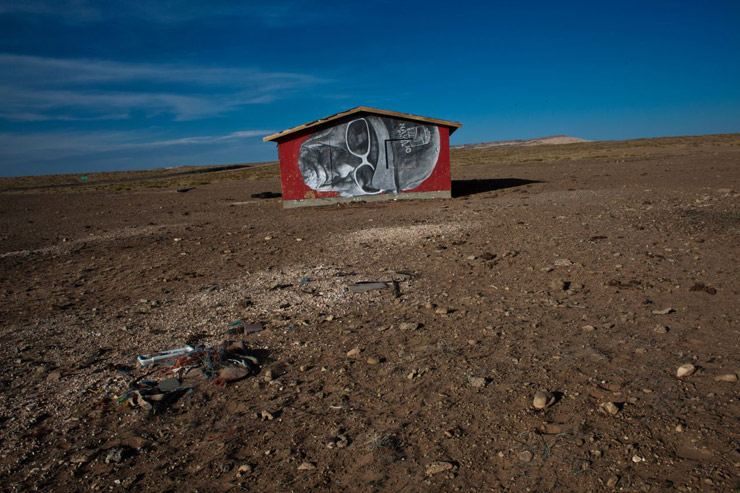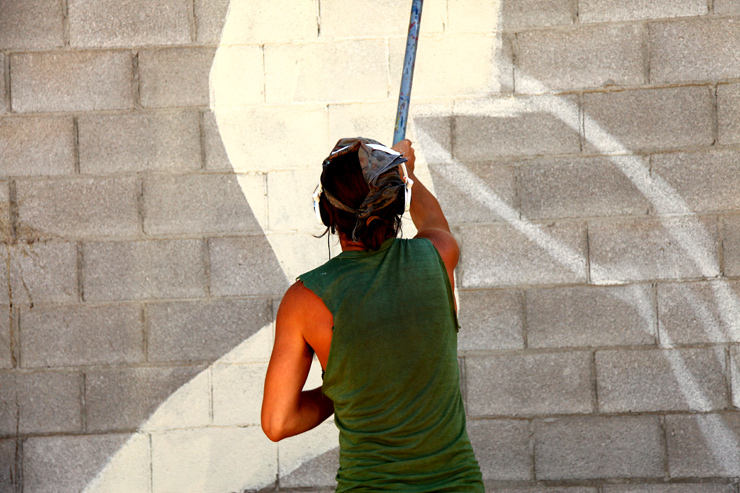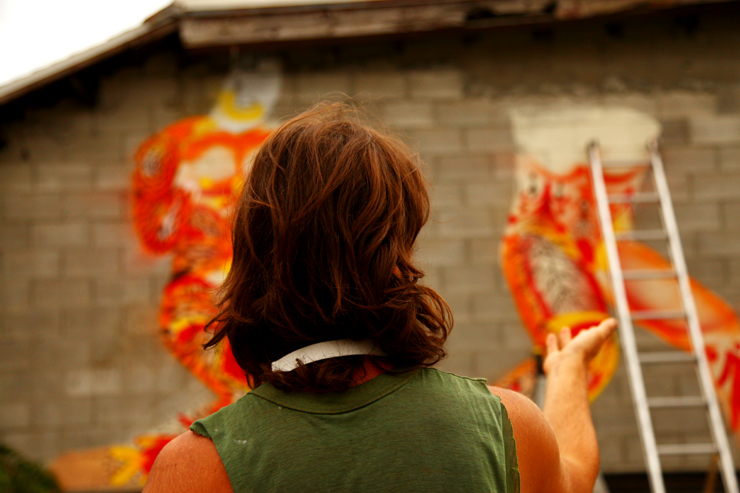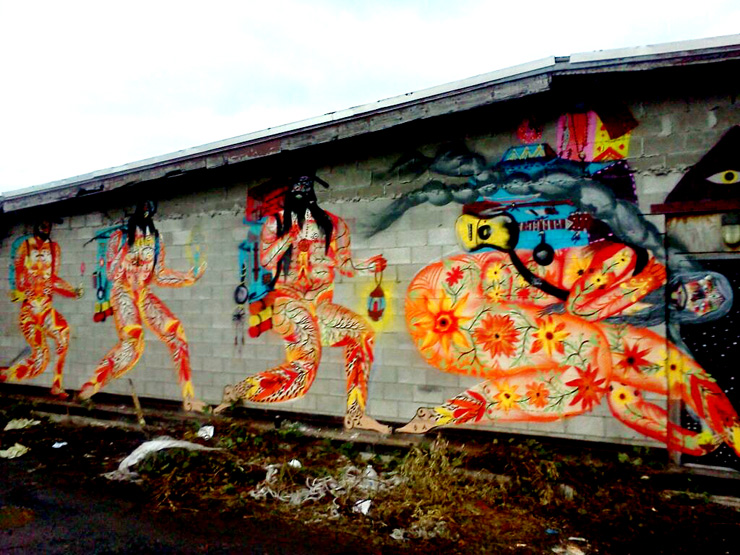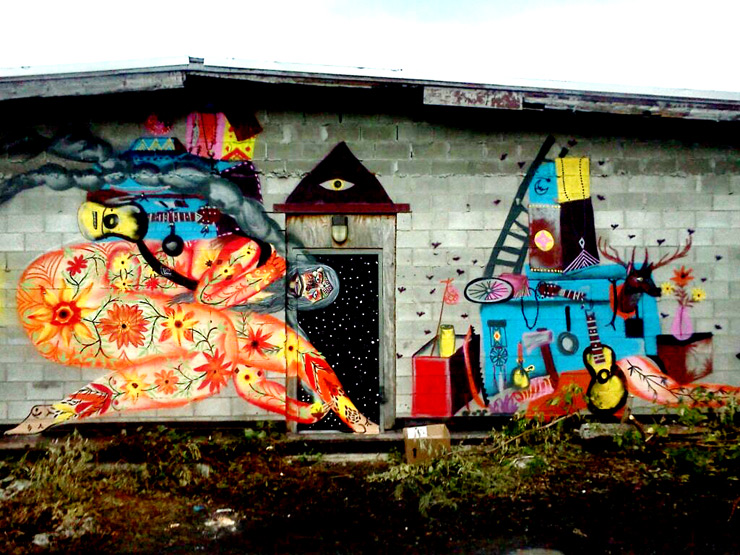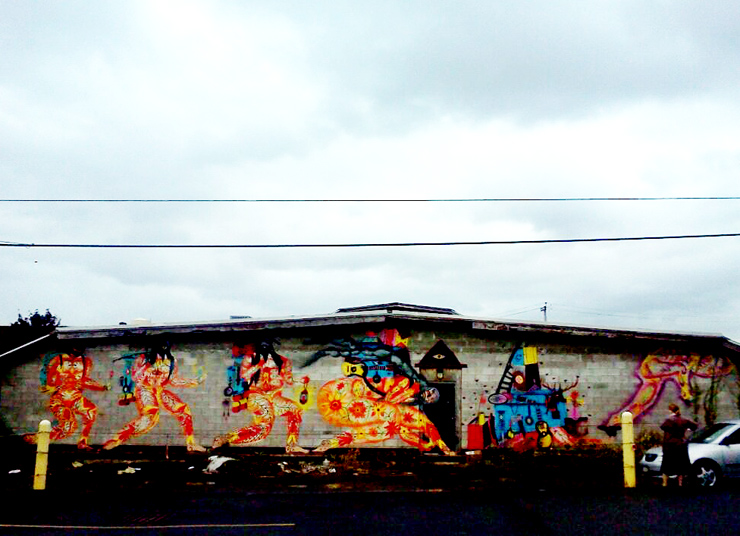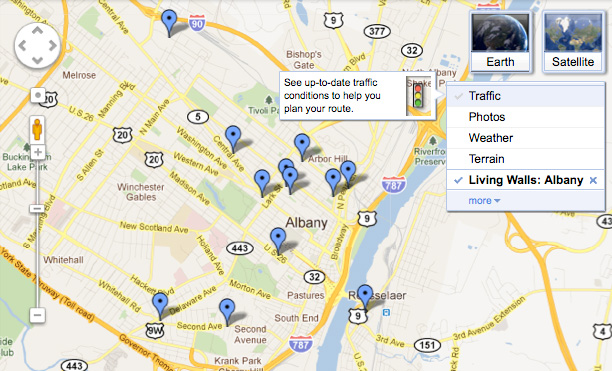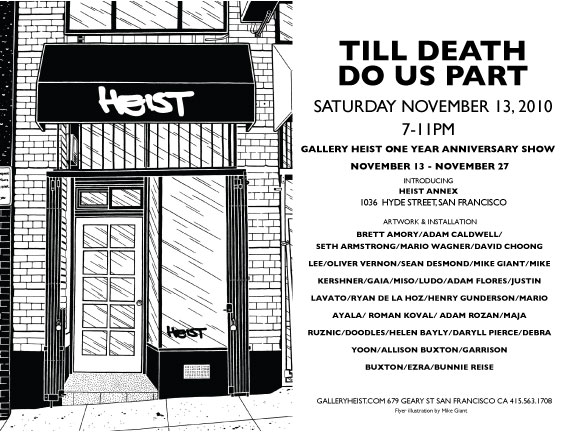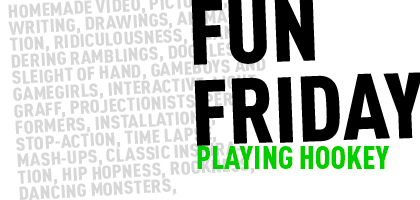It’s an unusual pairing: Street Artists who are accustomed to the grit and grime of deteriorating neighborhoods in the city translating their skills to the desert where the environment is outstandingly more natural than built.
In the third year of his experiment inviting artists to paint and wheat-paste in the Navajo Nation, organizer Chip Thomas, whose own street persona is Jetsonorama, appears to have hit a community service vein. “The relationship with the community became deeper,” he says as he relates the integration of some of the artists work relating directly to the history and the stories people tell in this sunbaked part of Arizona. More residency than festival, “The Painted Desert Project” began as a retreat offered to artists Thomas had met through his own association with Street Art festivals like Open Walls in Baltimore.
Troy Love Gates AKA OTHER. The Painted Desert Project 2014. Arizona. Navajo Nation. (photo © Jetsonorama)
Invited to come for an extended stay, compared to the 4 or 5 days of a typical Street Art festival, these artists are encouraged to study their new environment and to fully immerse themselves before conjuring a new work. Not only does the technique avoid the often levelled charge of cultural imperialism that is associated with the big festivals around the globe, it produces work that has impact and relevance to the community who will be looking at it year round.
Even though there can be a disconnect between the art and the community occasionally, as in the case of one work by the artist Troy Lovegates that was interpreted as being out of sync with some tastes, the majority of works are so closely related to people and the life here that a sense of ownership takes hold quickly. Any cultural worker associated with larger mural projects and programs in cities will tell you corollary stories about how the public responds to the voice of the artist, and one measure of success is the level of engagement by the community. “The project has always focused on creating art that is culturally sensitive,” says Thomas of his approach to the artists and the community, and he says that this year, “I feel like the project moved to the next level.”
Here are fresh images from the third installment of “The Painted Desert Project” that took place this spring and summer, along with some details about the works and their relationship to the people and places that hosted the artists.
Troy Lovegates AKA OTHER. The Painted Desert Project 2014. Arizona. Navajo Nation. (photo © Jetsonorama)
Street Artists Troy Lovegates and Labrona stayed for a few weeks in the Navajo nation and focused most of their work on a water tank in Rocky Ridge. While Lovegates initial mural was buffed when it “was found to be offensive by members of the community,” says Thomas, their new pieces on the tank were greatly embraced. “We were hosted in Rocky Ridge by the family of Louise Shepherd where we spent the night in a traditional hogan and ate food fresh from Louise’s garden.”
Labrona and Troy Lovegates AKA OTHER Detail. The Painted Desert Project 2014. Arizona. Navajo Nation. (photo © Jetsonorama)
Troy Lovegates AKA OTHER and Labrona. The Painted Desert Project 2014. Arizona. Navajo Nation. (photo © Jetsonorama)
Troy Lovegates AKA OTHER. The Painted Desert Project 2014. Arizona. Navajo Nation. (photo © Jetsonorama)
Labrona. Detail. The Painted Desert Project 2014. Arizona. Navajo Nation. (photo © Jetsonorama)
“In Beauty it is finished” by HYURO. The Painted Desert Project 2014. Arizona. Navajo Nation. (photo © Jetsonorama)
Street Artist Hyuro was created only her second mural in the US here this summer; significant because her first one in Atlanta for Living Walls last year featured nudity that set fire to the passions of religious sensitivities in the neighborhood that were further fanned by showboaters.
For “Painted Desert” the native of Valencia, Spain looked closely at the customs of the community when conceiving her depiction of a prayer ritual, which when viewed in this simple animation, reflects the connection native people have to their agricultural customs and history. “Moved by the simplicity and beauty of the traditional Navajo morning prayer Hyuro positioned her female figure facing the rising sun,” says Thomas, “and she illustrated the movements of this prayer that is performed with white corn pollen.”
HYURO. The Painted Desert Project 2014. Arizona. Navajo Nation. (photo © Jetsonorama)
HYURO. Local resident Sharston Woody is a storm rider on this vehicle people call a “4 track”. The Painted Desert Project 2014. Arizona. Navajo Nation. (photo © Jetsonorama)
Jaz and Mata Ruda. The Painted Desert Project 2014. Kaibeto, Arizona. Navajo Nation. (photo © Jetsonorama)
JAZ. The Painted Desert Project 2014. Kaibeto, Arizona. Navajo Nation. (photo © Jetsonorama)
New to the project this year were Street Artists Jaz, LNY, and Mata Ruda, each known for their large scale murals that are interpretive of history and in the case of the latter two, advocacy of social and political causes. This building “was part of the old Bureau of Indian Affairs school system from the 1950s to the 70s, after which it fell into disuse.” Shortly after the revival of the walls, says Thomas, the community began talking about making new plans to convert it into a youth center.
“Local food during the time Jaz, LNY, and Mata Ruda were here was catered by Mrs. Woody and her family,” says Thomas.
Mata Ruda. The Painted Desert Project 2014. Kaibeto, Arizona. Navajo Nation. (photo © Jetsonorama)
Jaz . Mata Ruda. The Painted Desert Project 2014. Kaibeto, Arizona. Navajo Nation. (photo © Jetsonorama)
JAZ. The Painted Desert Project 2014. Kayenta, Arizona. Navajo Nation. (photo © Jetsonorama)
Near Monument Valley in Kayenta, Arizona, the Argentinian Street Artist Jaz painted a mural inspired by the plight of wild horses that are starving due to overgrazed pastures, says Thomas. In the image the horses are running to escape capture, he says.
LNY. The Painted Desert Project 2014. Kaibeto, Arizona. Navajo Nation. (photo © Jetsonorama)
LNY at work. The Painted Desert Project 2014. Kaibeto, Arizona. Navajo Nation. (photo © Jetsonorama)
LNY. The Painted Desert Project 2014. Kaibeto, Arizona. Navajo Nation. (photo © Jetsonorama)
This vast view of Machu Picchu at the top is a cultural gift from the artist LNY to the community. “He wanted to bridge indigenous cultures of his home in Equador with that of the Navajo nation,” says Chip Thomas, the organizer of “The Painted Desert Project”.
Doodles . Avant Gardener. The Painted Desert Project 2014. Arizona. Navajo Nation. (photo © Jetsonorama)
In this mural the artists Doodles and Avant Gardener including important animals that are symbolic to the Navajo like the eagle and hawk, among traditional rug pattern designs, a mountain range, and a rainbow. LNY incorporated a small circle painting in black and white of a woman holding a lamb.
Monica Canilao prepping an installation. The Painted Desert Project 2014. Arizona. Navajo Nation. (photo © Jetsonorama)
Artists Doodles and Monica Canilao “turned my backyard into a fabrication shop, running chop saws and table saws late into the night,” says Thomas of their work to rebuild a roadside food stand that had burned to the ground. Having made friends with the proprietor, Mrs. Woody, during a previous edition of “Painted Desert,” the two constructed the sides of the food stand and painted them behind his home. As evidence of the bond created between residents and program participants, the artists spent 10 days doing this work, according to Thomas. The family of Mrs Woody came to the house often during the construction and painting to assist and to bring home made food to the artists. Since the artists departed at the end of the summer they have kept in contact with the Woodys via Facebook and Instagram.
>>>><<<>>><>><<>>>>>><<<<<>>><<<>>>>>>
Jetsonorama extends his most heartfelt gratitude to all the people who came together and help with donations of all kind to make this project possible, including to all the donors at http://www.gofundme.com/painted-desert-project
<<>>><><<>BSA<<>>><<<>><><BSA<<>>><><<>BSA<<>>><<<>><><BSA
Please note: All content including images and text are © BrooklynStreetArt.com, unless otherwise noted. We like sharing BSA content for non-commercial purposes as long as you credit the photographer(s) and BSA, include a link to the original article URL and do not remove the photographer’s name from the .jpg file. Otherwise, please refrain from re-posting. Thanks!
<<>>><><<>BSA<<>>><<<>><><BSA<<>>><><<>BSA<<>>><<<>><><BSA
This article is also published on The Huffington Post
 BROOKLYN STREET ART LOVES YOU MORE EVERY DAY
BROOKLYN STREET ART LOVES YOU MORE EVERY DAY